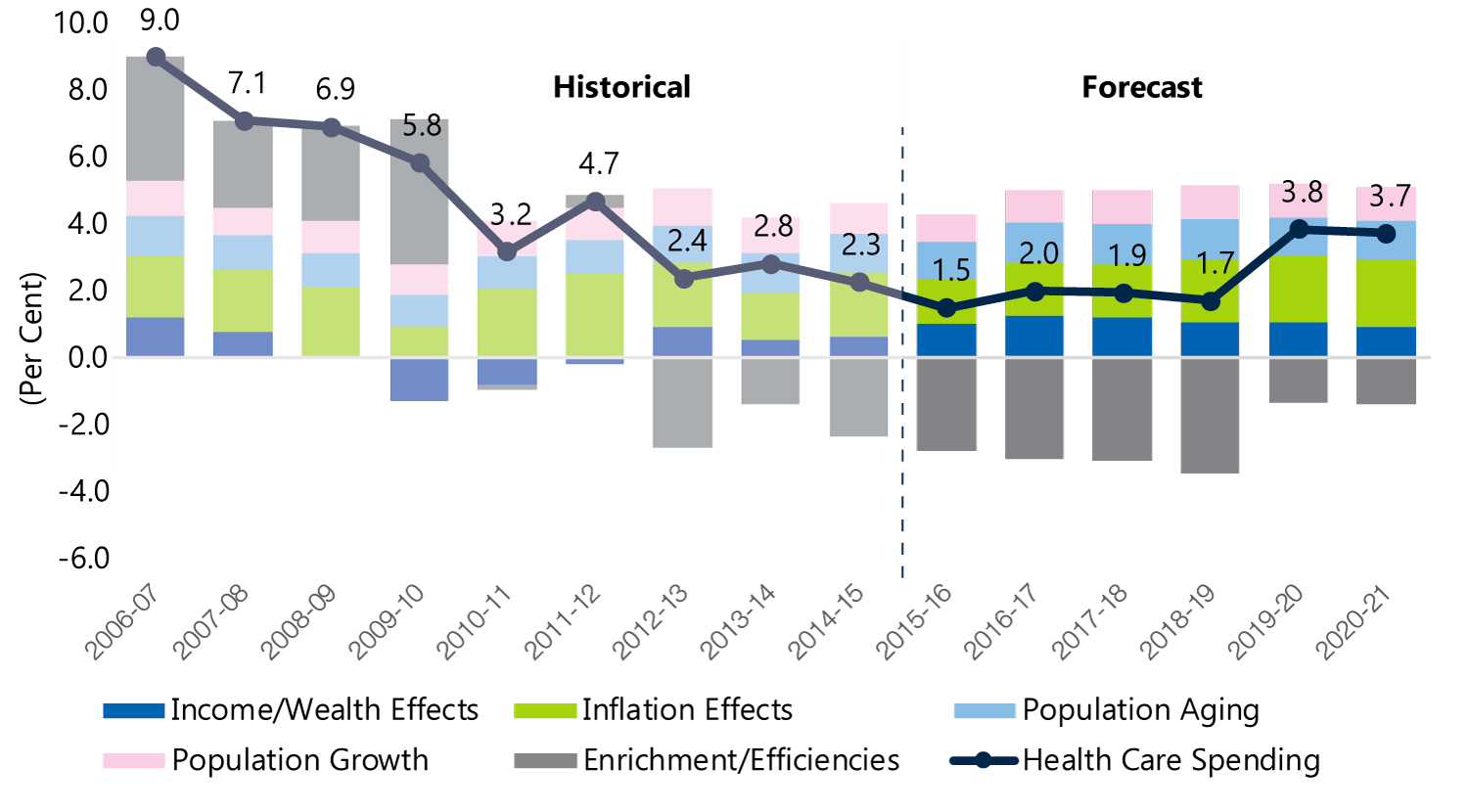1. Executive Summary
The FAO is forecasting solid growth for the Ontario economy, with real GDP rising by 2.5 per cent in both 2016 and 2017, in-line with the current average outlook of private sector economists. Beyond 2017, Ontario’s economic growth will moderate slightly, averaging 2.2 per cent per year. However, there are significant risks for both the global and Canadian economies that could lead to weaker economic growth for Ontario.
Consistent with the economic outlook, the FAO is forecasting provincial revenues to rise at an average annual rate of 3.8 per cent from 2014-15 to 2020-21, slightly below the revenue projection in the 2016 Ontario Budget forecast.[1] For program spending, the FAO outlook adopts the 2016 budget projection, which assumes average annual spending growth of 1.9 per cent over the 2014-15 to 2018-19 period. Beyond the budget outlook, the FAO projects program spending to increase by 3.4 per cent in 2019-20 and 2020-21, reflecting rising spending pressures from underlying demographics and higher costs of services.
Based on the revenue and spending outlooks, the FAO forecasts budget deficits of $5.7 billion in 2015-16, $4.0 billion in 2016-17, and $580 million in 2017-18, somewhat larger than the 2016 Ontario Budget projections.[2] However, given the flexibility built into the government’s fiscal projections, the Province is in a position to achieve its commitment of balancing the budget in 2017-18.
Beyond 2017-18, as revenue growth remains moderate, but spending pressures build, the FAO projects a gradual deterioration in the Province’s budget balance, with a deficit of $1.7 billion by 2020-21.
Ontario Budget Balance
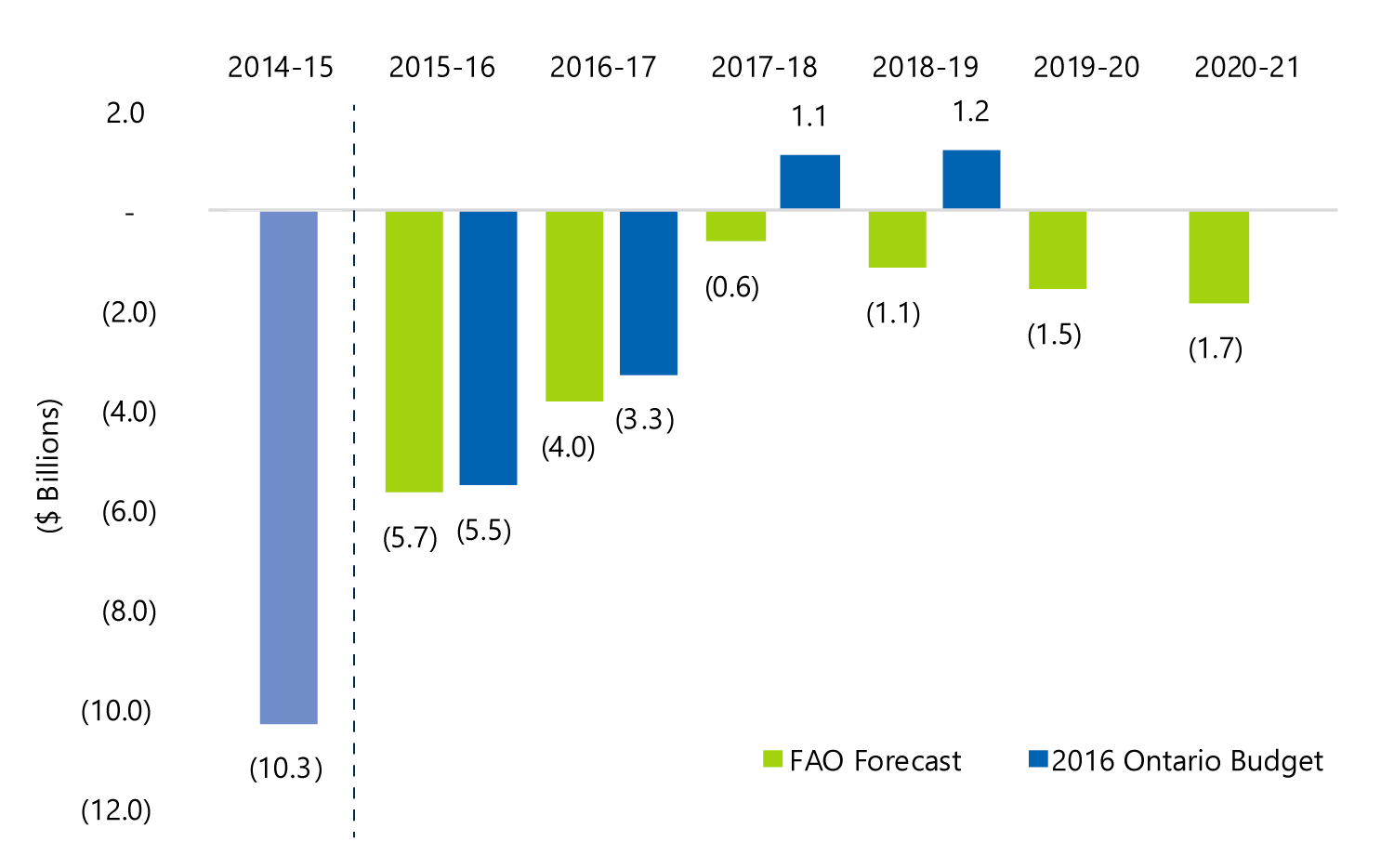
Notes: Budget balance before reserve. The government’s fiscal projection extends from 2016-17 to 2018-19.Source: 2016 Ontario Budget and FAO
Source: Ontario Public Accounts and FAO
Key Risks
The FAO fiscal outlook is broadly consistent with the consensus forecast for the economy as well as the government’s own projections for program spending to 2018-19. However, there are a number of significant risks to this outlook including weaker than expected economic growth and higher than planned program spending.
If the economy grows somewhat more slowly than expected and maintains the average pace of growth of the past five years, revenues would be lower and the budget deficit would be $1.4 billion in 2017-18, and deteriorate to $3.5 billion by 2020-21.
Over the next four years, the government plans to restrain spending below the growth of underlying demographic and cost pressures. Based on FAO analysis, if the Province were to allow program spending to grow in-line with underlying cost and demographic factors, program expenses would be $4.0 billion higher by 2018-19, compared to the 2016 budget.
The FAO outlook also adopts several key policy assumptions implicit in the government’s fiscal plan. However, if the actual fiscal outcomes differ from the government’s assumptions, there could be a material impact on the government’s budget balance. These assumptions include:
- Ontario’s continued receipt of Equalization payments, estimated to be $1.6 billion by 2020-21;
- $1.3 billion by 2017-18 in new revenues from federal transfers continuing over the medium-term;
- $1.9 billion by 2017-18 in new revenues from the cap-and-trade program to reduce greenhouse gas emissions.
Ontario Debt
As a result of projected budget deficits combined with the government’s large infrastructure spending plans, Ontario’s net debt is forecast to rise by approximately $54 billion over the next five years to $350 billion.
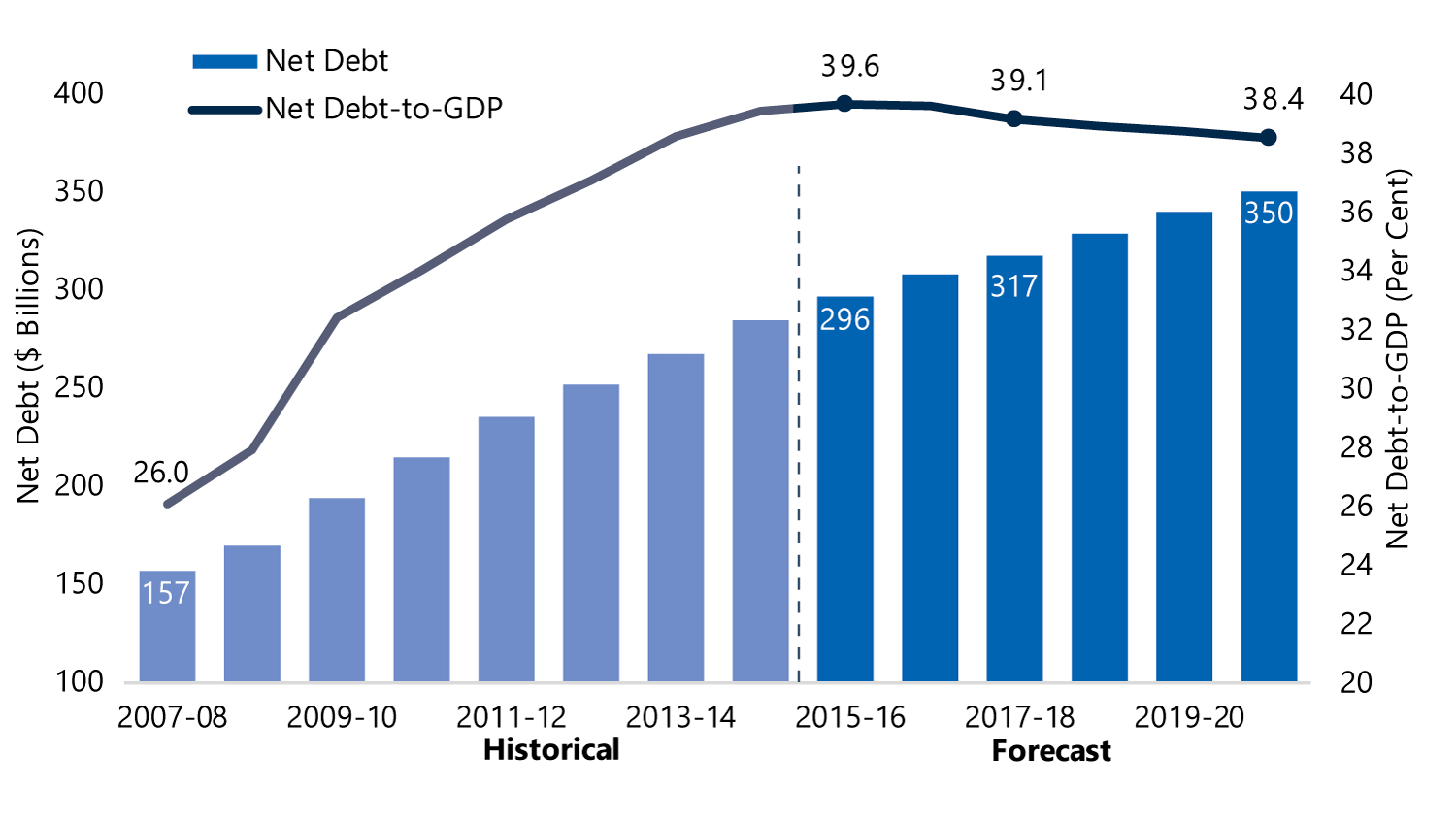
The FAO projects that Ontario’s net debt-to-GDP ratio – a standard measure of debt burden – will peak at 39.6 per cent in 2015-16 and then decline modestly to 38.4 per cent by 2020-21, a decrease of approximately one percentage point over five years.
The Province has committed to reduce the net debt-to-GDP ratio to 27 per cent, approximately 11 percentage points below the projected value in 2020-21, but has not provided details of how or when it plans to achieve this goal.
2. Economic Outlook
Overview
Steady Economic Growth Expected for Ontario
The Ontario economy has posted solid growth over the past two years, with real GDP rising by 2.7 per cent on average in 2014 and 2015.[3] Strong gains in household spending and residential investment were key drivers of the economy’s strength. In addition, investment in machinery and equipment increased by almost seven per cent in each of the past two years, providing encouraging evidence that Ontario businesses are expanding.
Solid Recent Gains in Ontario Real GDP Extend into 2016 and 2017
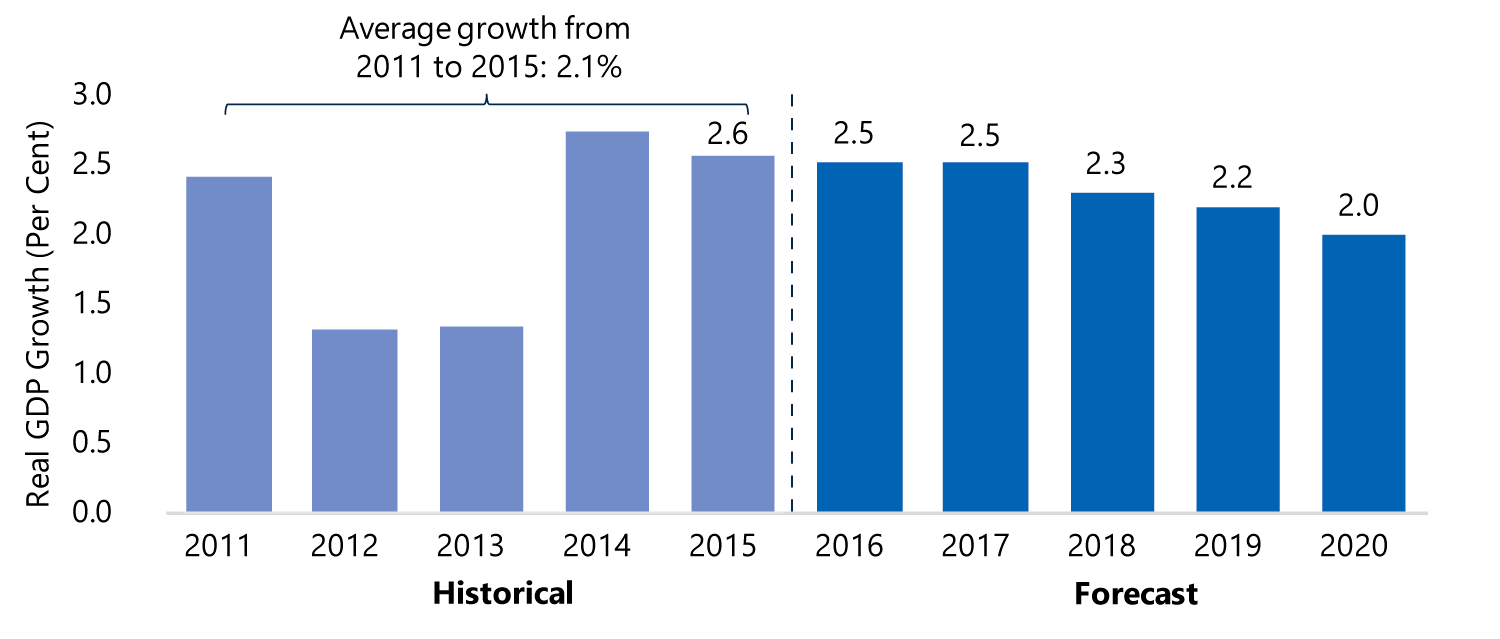
Source: Statistics Canada, Ontario Ministry of Finance and FAO
The FAO expects Ontario’s economy to outperform the rest of Canada in 2016, as Ontario’s exports benefit from solid growth in the U.S. and a low Canadian dollar. The FAO is forecasting real GDP to rise by 2.5 per cent in both 2016 and 2017, in-line with the current average outlook of private sector economists.
Beyond 2017, the FAO expects Ontario’s economic growth to moderate slightly, with real GDP increasing 2.2 per cent on average. However, there are significant risks for both the global and Canadian economies that could lead to weaker economic growth for Ontario over the outlook.
Global Economic Growth Expected to Remain Weak
According to the International Monetary Fund’s (IMF) latest estimate[4], global economic growth slowed to 3.1 per cent in 2015, the weakest pace of growth since the 2008-2009 recession.
Global Growth Expected to Improve Moderately over Outlook
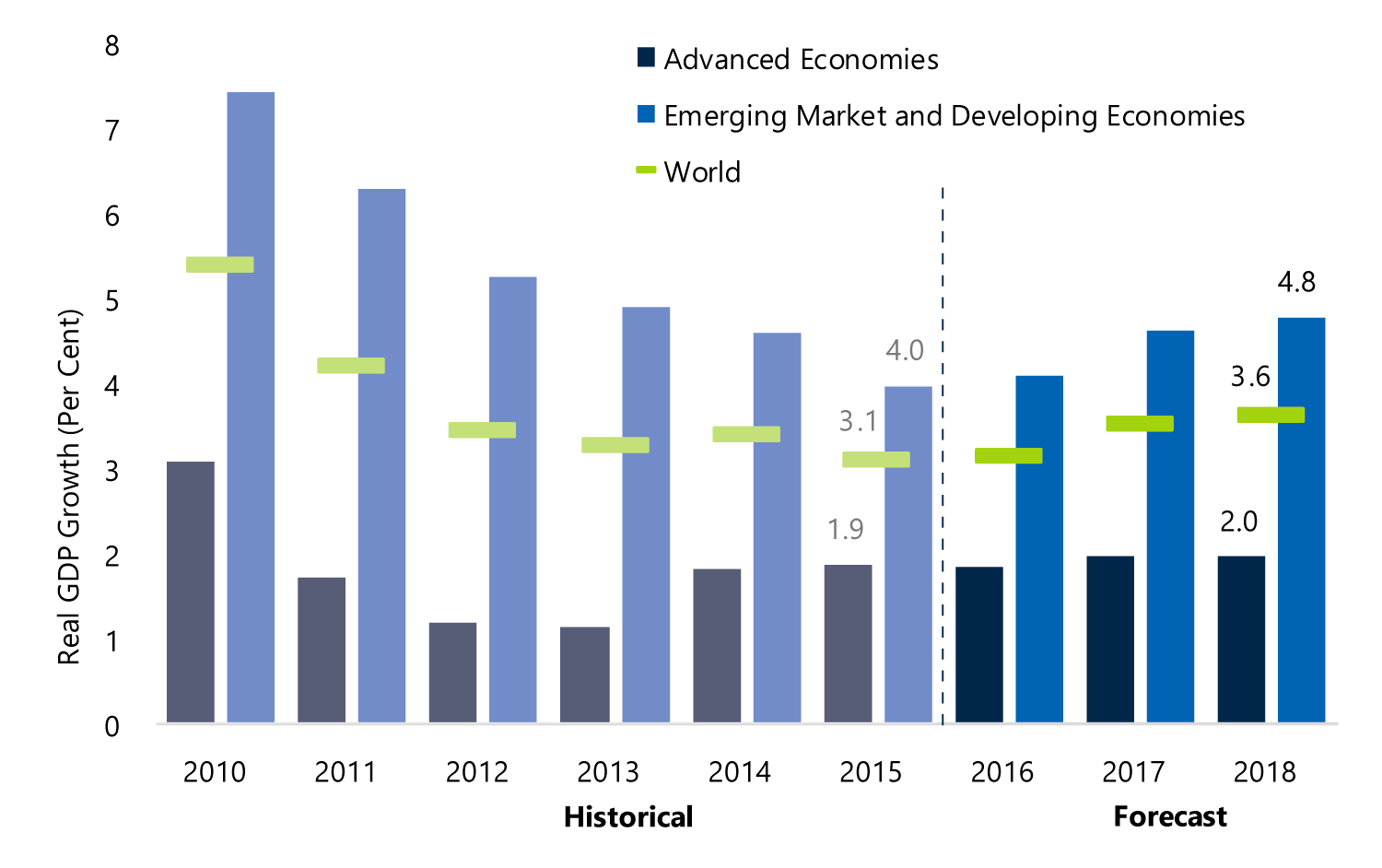
Source: International Monetary Fund (April 2016)
Global economic conditions were uneven in 2015. Lower commodity prices and increased financial market volatility contributed to a sharp deceleration in economic activity in emerging and developing market economies. Growth in these economies was 4.0 per cent in 2015, down from 4.6 per cent in 2014 and the fifth consecutive year of slower growth. The globally important Chinese economy grew by 6.9 per cent in 2015, a marked slowdown from growth of over 10 per cent in 2010. Growth for emerging and developing market economies is expected to modestly improve over the next two years.
Advanced economies grew by 1.9 per cent in 2015, with the U.S. recording a solid 2.4 per cent gain. Growth in advanced economies is expected to rise at the same rate of 1.9 per cent in 2016.
In its latest report, the IMF revised down its outlook for 2016 global growth by 0.2 percentage points to 3.2 per cent, the second downward revision for the 2016 forecast. For 2017, the IMF is forecasting world growth of 3.5 per cent, also weaker than its earlier projections.
U.S. Outlook Remains Positive
Despite generally weak global economic conditions and a strong U.S. dollar, the U.S. economy has remained a bright spot in the global economy with real GDP advancing 2.4 per cent in 2015.
Following a volatile start to 2016, recent U.S. indicators are generally encouraging, pointing to continued steady growth. The U.S. labour market has recorded average monthly employment gains exceeding 200,000 over the last 12 months, while the U.S. unemployment rate has continued to trend lower, reaching five per cent in March 2016.
According to the Federal Reserve Board’s survey of economic forecasters, U.S. real GDP is projected to grow by 2.2 per cent in 2016.[5] Forecasters continue to expect household spending to be a key driver of overall economic growth in 2016, with rising incomes and lower energy prices contributing to an increase in the purchasing power of U.S. households. In 2017 and 2018, U.S. growth is expected to average
2.1 per cent.
Steady Growth in U.S. Economy Expected
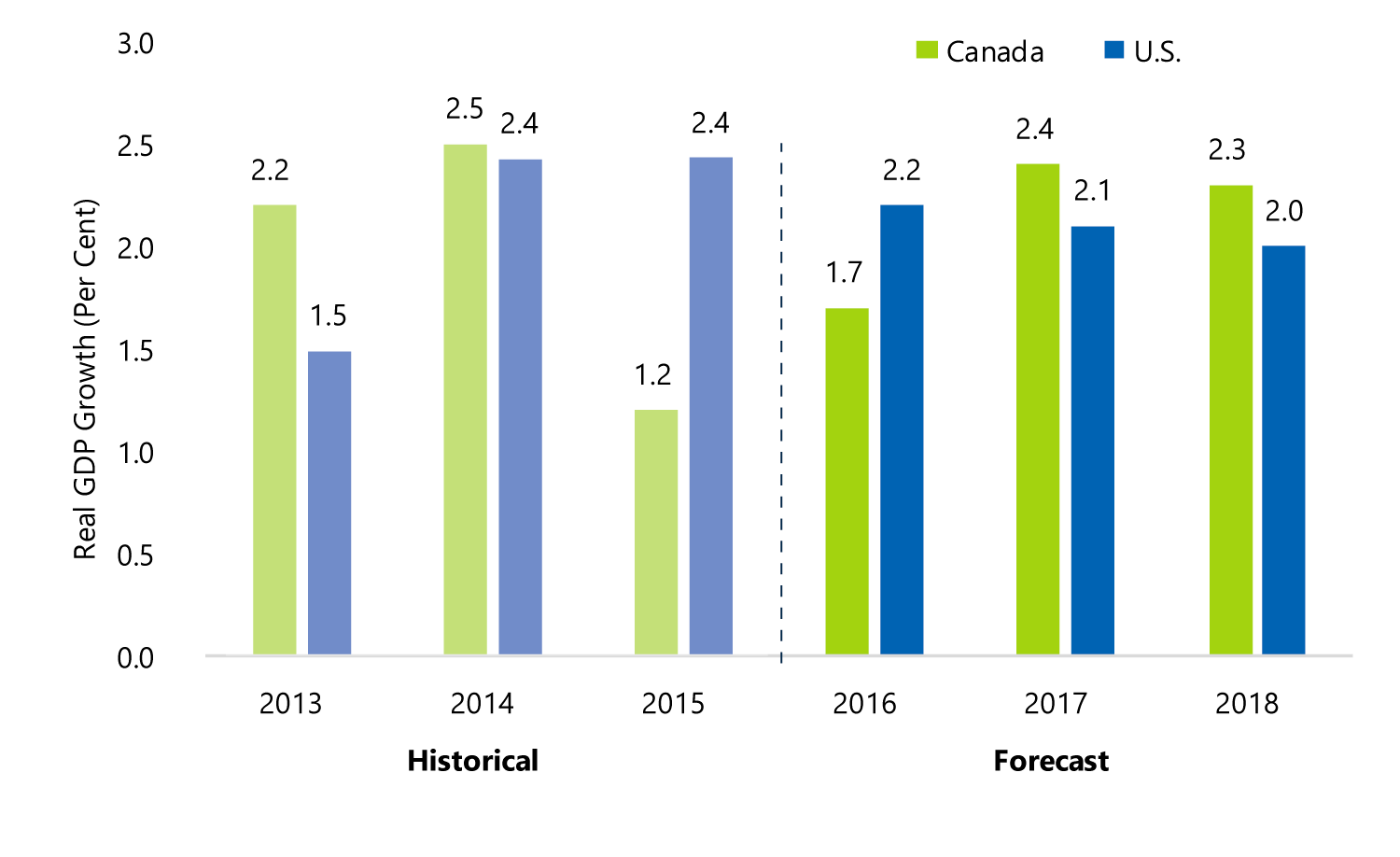
Source: Statistics Canada, FAO, U.S. Bureau of Economic Analysis and Federal Open Market Committee
Canadian Outlook: Diverging Provincial Economies
Canadian real GDP is forecast to grow by 1.7 per cent in 2016, following a modest 1.2 per cent gain in 2015.[6]
Recent economic performance within Canada has been uneven. Lower oil prices have negatively impacted the economies of Alberta, Saskatchewan and Newfoundland & Labrador, while non-oil producing provinces - including British Columbia, Ontario and Manitoba - have generally benefited from lower oil prices and exchange rate.
The sharp drop in oil prices continues to take its toll on the economies of oil- producing provinces, with significant capital spending reductions in the energy sector. According to a report from the Canadian Association of Petroleum Producers[7], capital spending in the oil and gas sector is expected to drop to $31 billion in 2016 from a high of $81 billion in 2014.
Ontario Among Growth Leaders in 2016 and 2017
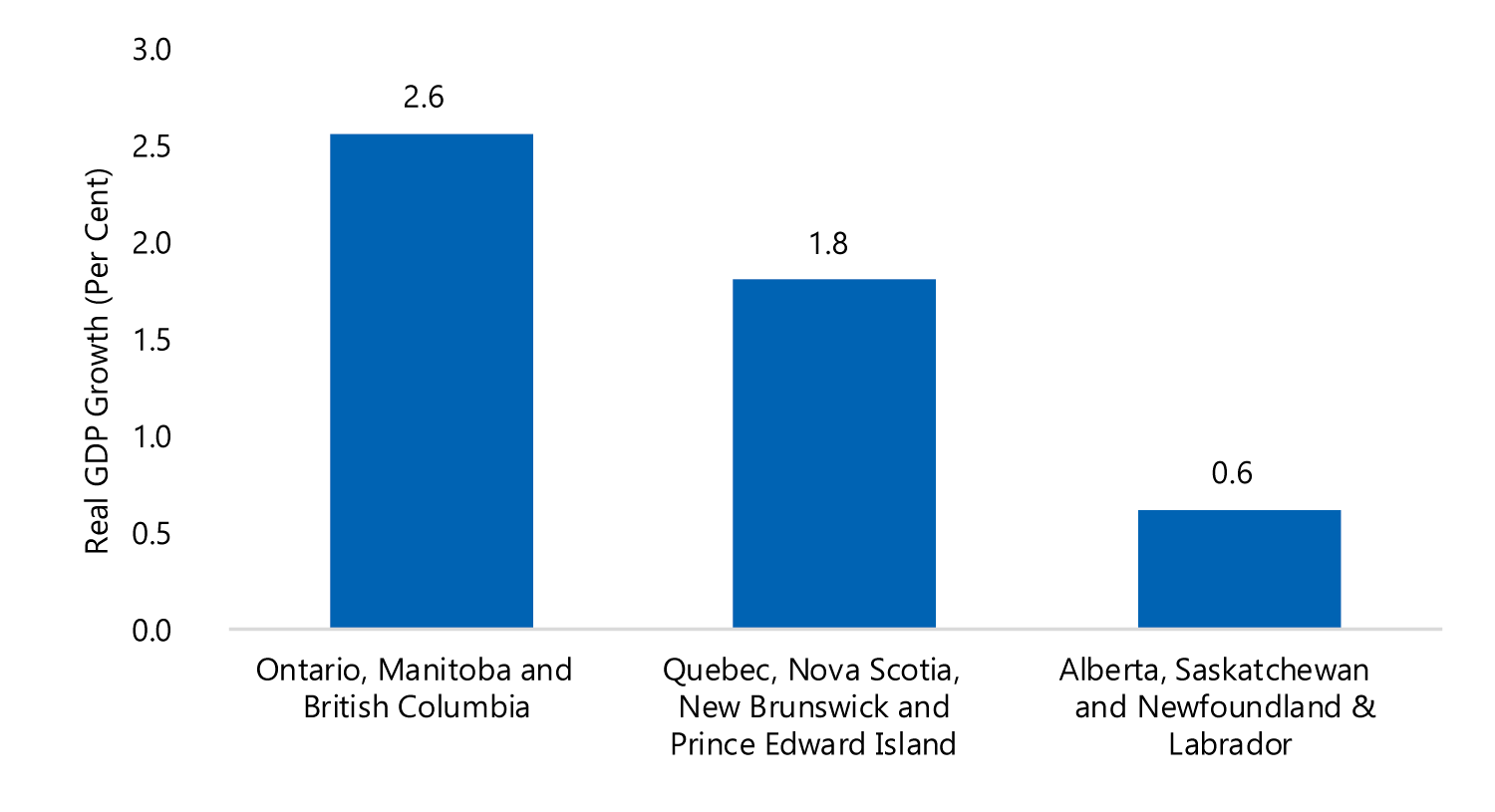
Source: Conference Board of Canada, Winter 2016 Forecast
The Canadian economy is expected to gradually adjust to lower energy prices, as a steady strengthening of non-energy exports, supported by higher business investment, helps to offset the slower growth in the oil and gas sector.
Given the protracted nature of the adjustment process for Canada’s economy and challenges posed by the uneven pace of global growth, the Bank of Canada is not expected to raise interest rates before 2017. Beyond 2017, as the Canadian economy continues to recover from the recent drop in oil-prices, interest rates are expected to rise, returning closer to historically normal levels.
Short-and Long-term Borrowing Rates
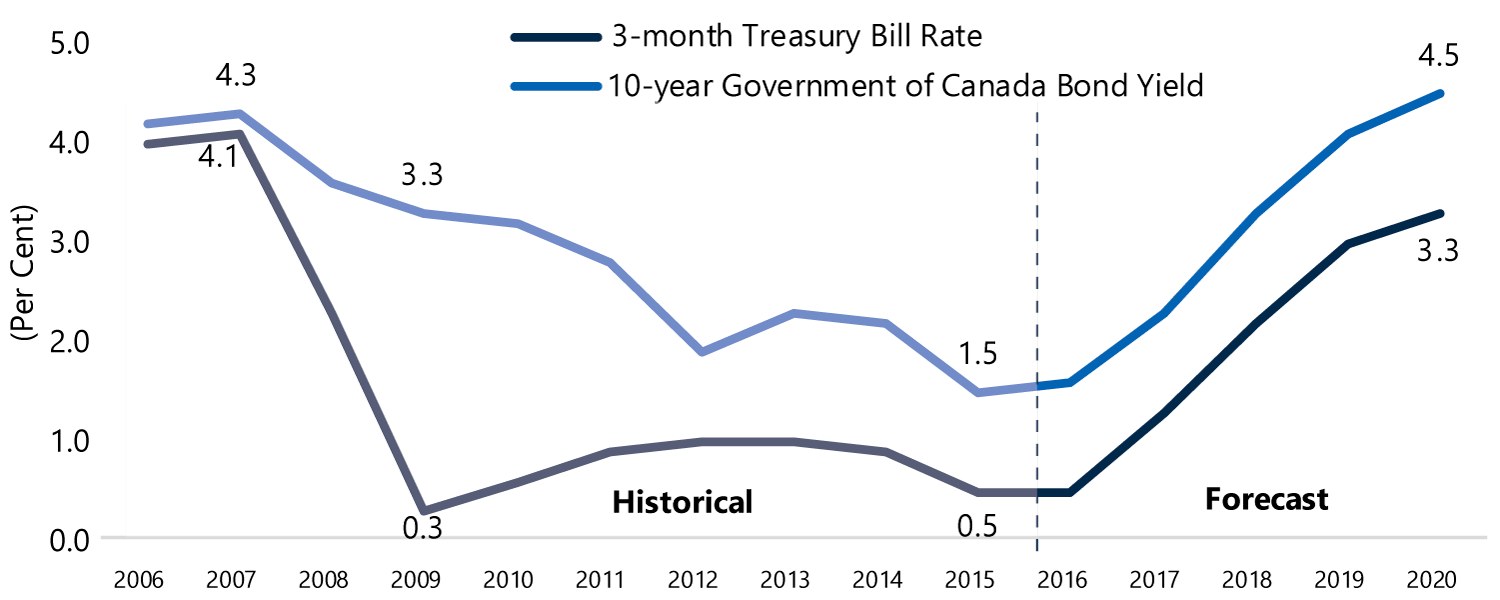
Source: Statistics Canada and FAO
Ontario Economic Outlook
The FAO is forecasting Ontario real GDP to grow by 2.5 per cent in 2016 and 2017 and by an average of 2.2 per cent from 2018 to 2020.[8] Nominal GDP is forecast to grow by 4.2 per cent in 2016 and 2017 and by an average of 3.9 per cent over the remainder of the outlook.
Ontario GDP Outlook
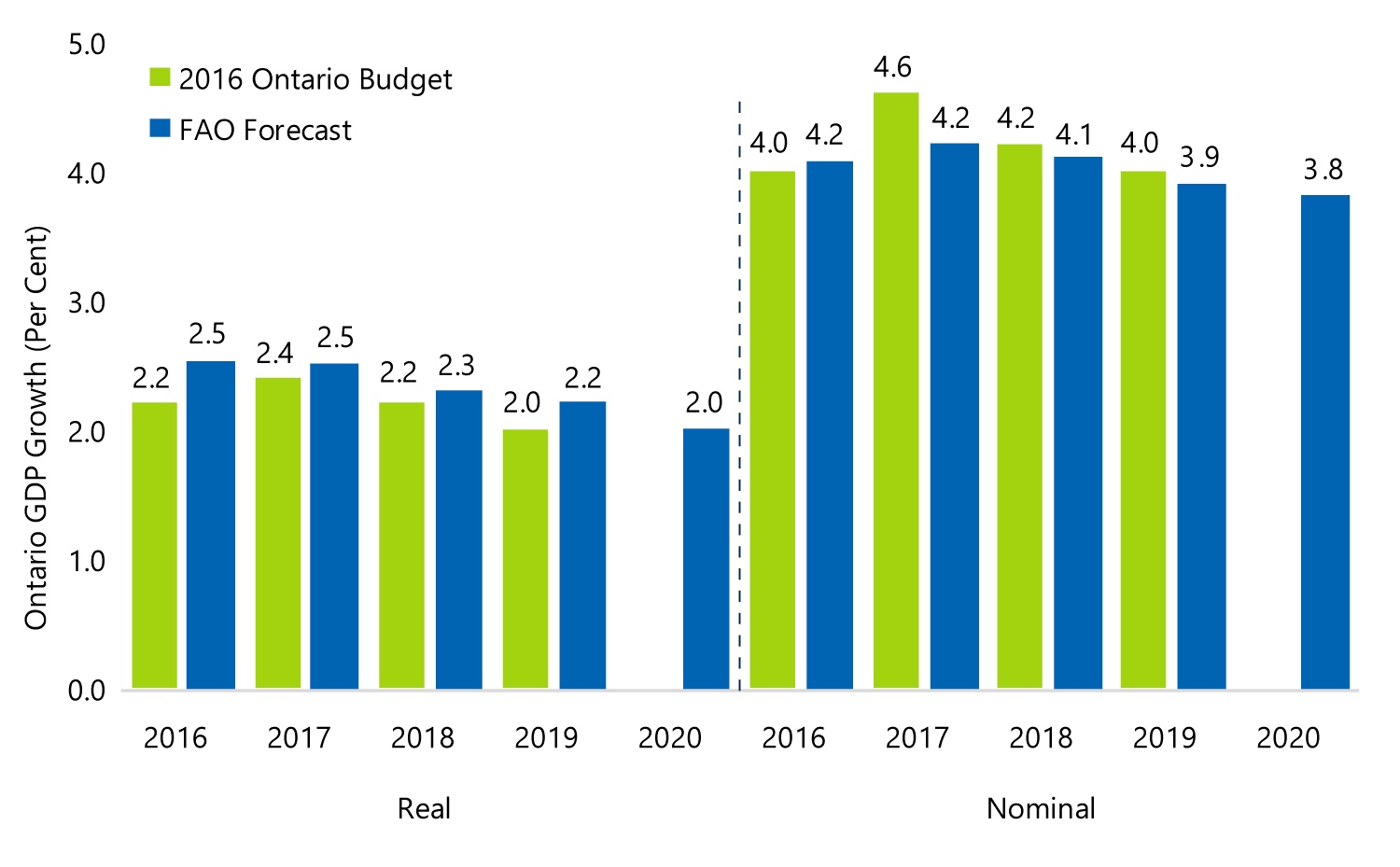
Source: 2016 Ontario Budget and FAO
The FAO forecast for the Ontario economy in 2016 is based on the recently released Ontario Economic Accounts[9] combined with analysis of recent economic indicators and the expected quarterly path of the economy through 2016. For 2017 through 2020, the FAO forecast adopts the average outlook of three external organizations that maintain model-based economic forecasts for Ontario: the Conference Board of Canada, the Centre for Spatial Economics, and the Policy and Economic Analysis Program (PEAP) at the University of Toronto (See Appendix A: Table 3).[10]
The FAO forecast for the Ontario economy is generally consistent with the consensus view among economists that Ontario’s economic growth over the next several years will be driven by stronger international exports and business investment. The gradual moderation in the overall pace of economic growth after 2018 largely reflects more modest growth in household spending and residential construction as households increase savings in reaction to the elevated levels of personal debt. In addition, strong export gains over the next couple of years are expected to moderate beyond 2018, consistent with a slight appreciation in the Canadian dollar and steady, but moderate, U.S. growth.
Ontario’s Labour Market to Strengthen
Ontario employment increased by a modest 45,000 net jobs in 2015 (+0.7 per cent), following a similarly modest gain of 55,000 net jobs (+0.8 per cent) in 2014. Despite the slow pace of job gains, the unemployment rate edged down to 6.8 per cent in 2015, the lowest rate since 2008. Over the first three months of 2016, Ontario’s labour market has posted solid gains, adding about 90,000 jobs on a year-over-year basis, pointing to potentially stronger job gains in 2016.
Employment is expected to grow steadily over the outlook, reflecting the growth in the economy. On average, Ontario employment is forecast to grow by just over one per cent per year, adding 80,000 net new jobs on average per year. The projected gains in employment, combined with moderate growth in the labour force will result in the unemployment rate gradually declining to 6.0 per cent by 2020.
Ontario Employment Growth Remains Moderate
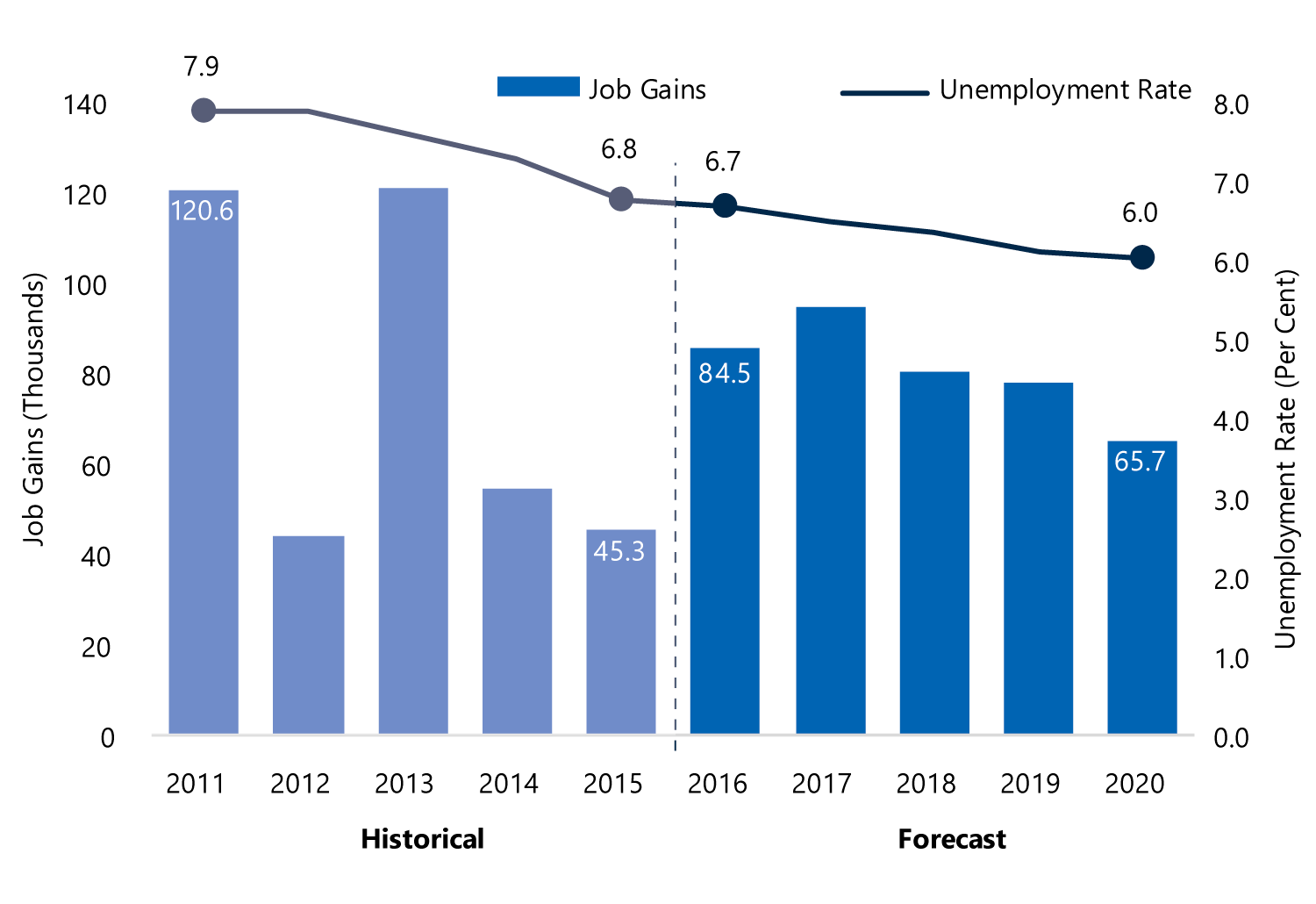
Source: Statistics Canada and FAO
The steady growth in employment, combined with moderate wage gains will result in solid growth in labour income of approximately 4.0 per cent per year over the outlook.
Key Risks to the Outlook
Over the next several years, most economic forecasters, including the FAO, expect the Ontario economy will grow at a solid pace, supported by gains in international exports and business investment.
However, there are a number of key risks that could lead to weaker economic outcomes for Ontario. In particular:
U.S. economic growth could be lower than expected, leading to softer demand for Ontario’s exports. In particular, recent weakness in U.S. consumer spending and investment in the oil and gas sector could hold back growth in U.S. domestic demand. In addition, it is unclear if Ontario will regain the U.S. market share it lost to Mexico and China.[11] As a result, the rebound for Ontario’s manufacturing sector could be more muted than expected which could also dampen the anticipated rebound in business investment.
The on-going transition of the Chinese economy to slower but more balanced growth could lead to further swings in commodity prices and renewed bouts of financial market volatility.[12] In particular, this could lead to further deterioration in conditions for emerging market economies, many of which are already struggling with recessions. These global forces could have more severe, negative effects on the Canadian and Ontario economies.
Domestically, the sharp run-up in housing prices, particularly in Toronto, combined with elevated levels of household debt also present a key risk for the Ontario economy. An unexpected sharp increase in interest rates or unemployment could lead to a housing price correction that would negatively impact household spending and residential construction, leading to further job losses.
3. Ontario Fiscal Outlook
Overview
Balanced Budget Achievable in 2017-18, But Maintaining Balance Will Be Challenging
The FAO has developed a fiscal outlook for Ontario, based on detailed projections for revenues, program spending and interest on debt.[13]
The FAO’s revenue forecast is consistent with the economic outlook described in the previous section and includes revenue measures outlined in the 2016 Ontario Budget. The FAO’s spending outlook adopts the government’s own program spending projections published in the 2016 Budget.[14] For 2019-20 and 2020-21, the FAO outlook assumes program spending will increase with underlying demographic and cost pressures.
Based on the outlook for revenues and spending, the FAO projects budget deficits of $5.7 billion in 2015-16, $4.0 billion in 2016-17, and $580 million in 2017-18, somewhat larger than the deficit projections (before the reserve) from the 2016 Budget.
The FAO’s projection assumes no policy adjustments by the government. However, given the flexibility built-into the government’s fiscal projections, as well as available
policy options[15], the Province is in a position to achieve its commitment of balancing the budget in 2017-18.[16]
Ontario Budget Balance

Notes: Budget balance before reserve. The government’s fiscal projection extends from 2016-17 to 2018-19.
Source: Ontario Ministry of Finance and FAO
Beyond 2017-18, as revenue growth remains moderate, but spending pressures build, the FAO projects a gradual deterioration in the budget balance, with a deficit of $1.7 billion by 2020-21. By comparison, the 2016 Budget forecasts surpluses (before the reserve) of $1.1 billion in 2017-18 and $1.2 billion in 2018-19.
There are a number of significant risks for the Province’s fiscal outlook. From 2014-15
to 2018-19, the government plans to restrain spending growth to well below the growth of underlying demographic and cost pressures. It is unclear to what extent the government will achieve this level of spending restraint or what the implications are for public services.
It is also possible that the Ontario economy could underperform relative to economic forecasts, putting further pressure on the government’s fiscal plan. A scenario of more moderate economic growth would result in a deficit of $1.4 billion by 2017-18, and $3.5 billion by 2020-21.
Revenue Outlook
The FAO projects Ontario’s total revenues will grow at an average pace of 3.8 per cent per year over the revenue outlook, faster than the 2.6 per cent pace of revenue growth over the last four years.[17] Stronger revenue growth over the outlook is largely the result of stronger growth in tax revenues and federal transfers.
The FAO’s revenue outlook incorporates a number of new revenue sources announced in the 2016 budget, including $1.1 billion from further asset sales[18], $1.9 billion by 2017-18 from the sale of emission permits under the new cap-and-trade program, and $1.3 billion in expected new federal transfers by 2017-18. In addition, the FAO revenue forecast incorporates all major tax measures and administrative adjustments announced in recent budgets.
Revenue Outlook Before and After Measures
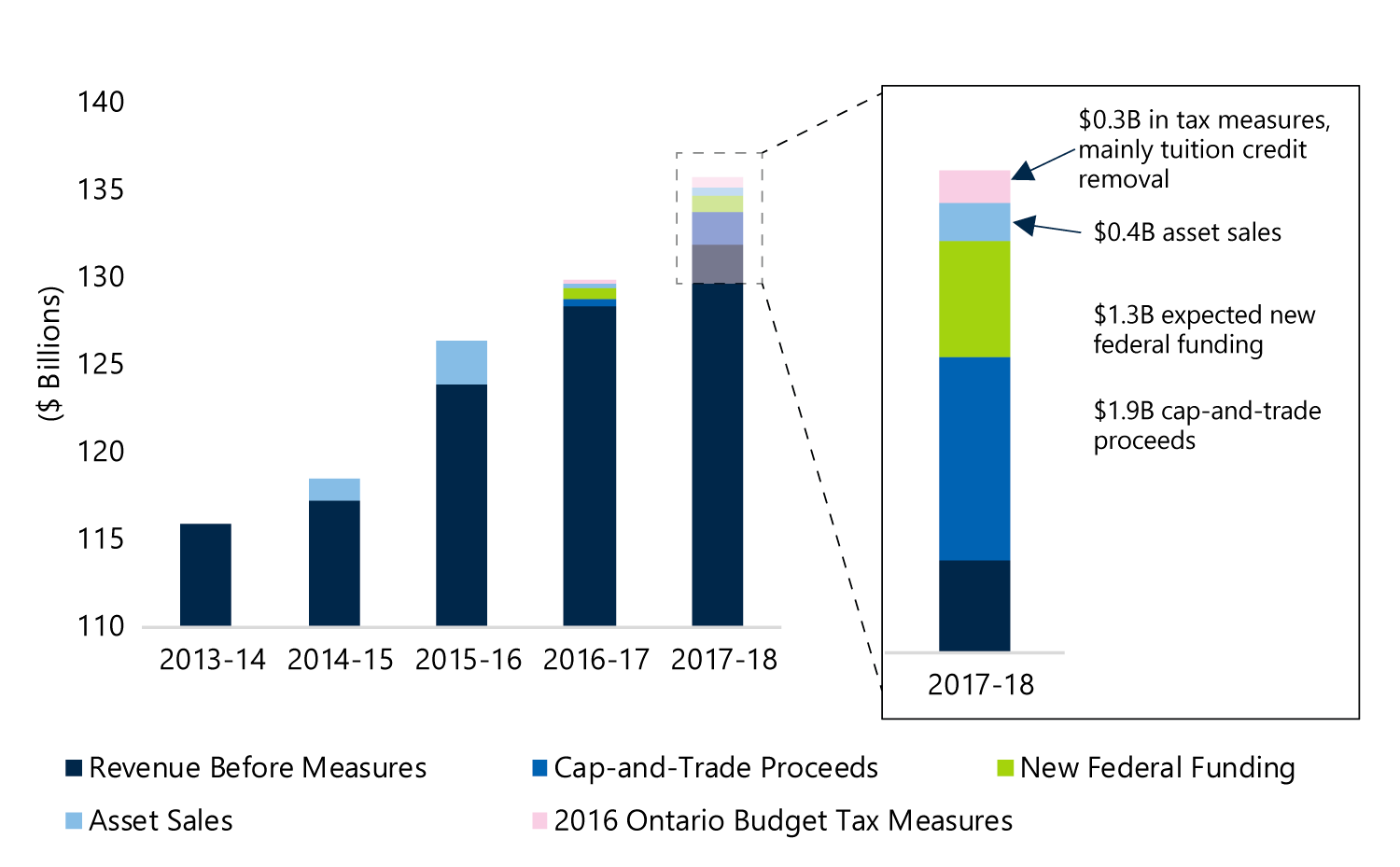
Note: 2017-18 includes $0.8B asset sales, and -$0.4B in lost H1 and PIL revenue.
Source: Ontario Ministry of Finance and FAO
Taxation Revenue
Stronger revenue growth over the outlook is mainly the result of higher growth in tax revenue. The FAO projects total tax revenue growth will average 4.3 per cent per year over the outlook, much stronger than the 3.5 per cent rate of growth in the
past four years.
This stronger pace of growth in tax revenues flows from the expected improvement in Ontario’s economic performance. Ontario’s nominal GDP - the broadest single measure of the tax base – is projected to grow by 4.0 per cent from 2014 to 2020. Many key economic drivers of government tax revenue, including nominal GDP, labour income and corporate profits, are expected to grow at stronger rates than recent history.
Growth in Key Tax Drivers[19]
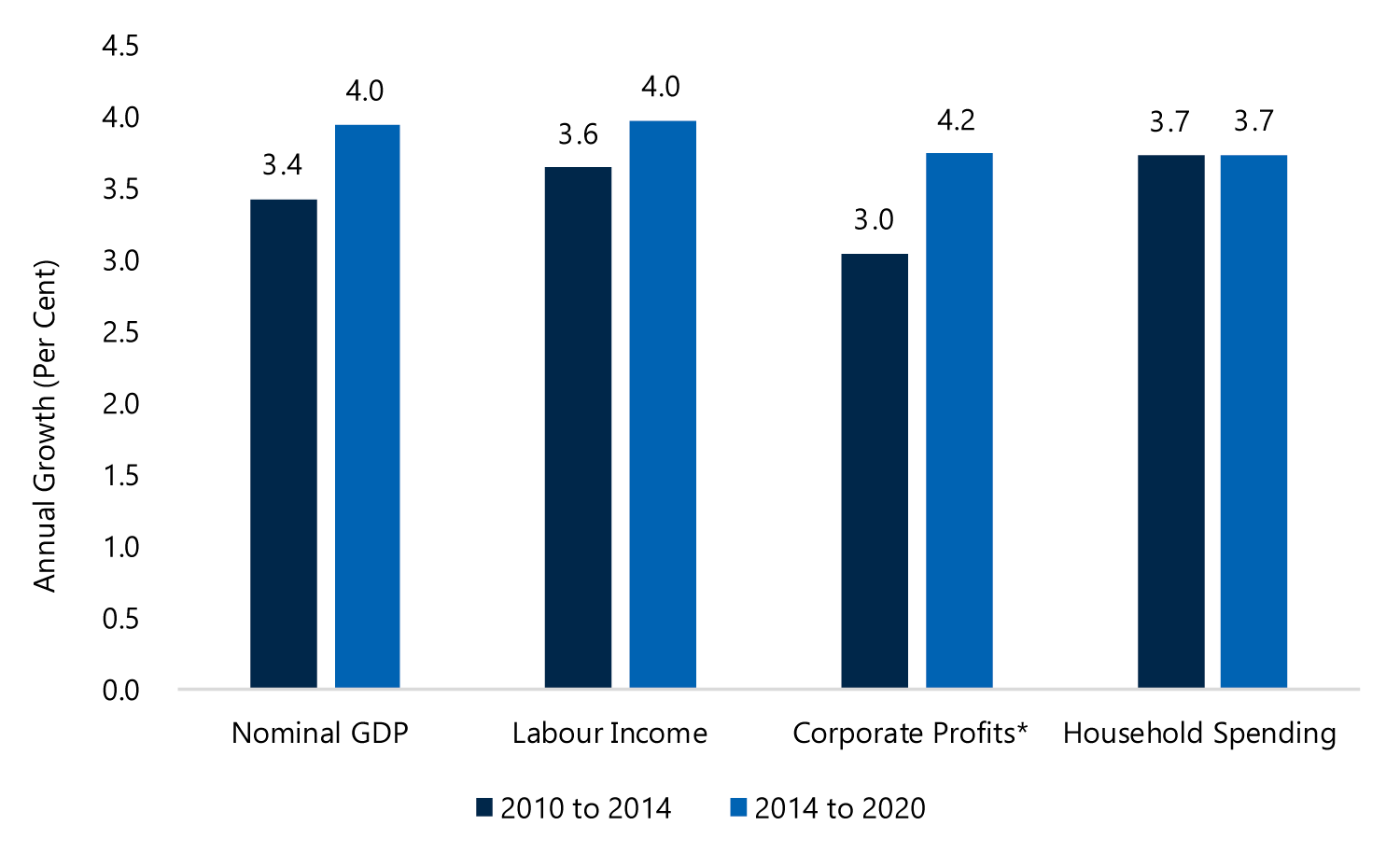
*Corporate Profits data are volatile. History is 2012 to 2014 to exclude the post-crisis rebound in 2011.Source: Statistics Canada and FAO
Improvements in these key economic indicators result in higher personal income tax revenues from stronger income growth[20], higher corporate income tax revenues from solid gains in corporate profits and steady sales tax revenue growth from household consumption.
The tax revenue forecast is sensitive to economic conditions, including the economic risks outlined in the Economic Outlook section.
Federal Transfer Revenue
Largely consistent with the government’s 2016 Budget projection, federal transfers are expected to grow by 4.0 per cent over the forecast period.
The 2016 Ontario Budget assumed that the Province would receive $1.3 billion in new revenues for federal commitments for infrastructure, home care and labour-market training programs by 2017-18. However, the duration and nature of these new revenues, including whether the Province will be required to increase its own spending to match new revenues, have yet to be clarified.[21]
Equalization payments to Ontario are projected to decline over the outlook due to Ontario’s improving fiscal capacity relative to the rest of Canada.
However, Ontario’s Equalization payment - estimated to be $1.6 billion in
2020-21 - could be eliminated entirely if the province’s fiscal capacity remains
above the national average or if the federal government changes the rules governing the program.
Government Business Enterprises
Consistent with the 2016 budget, income from government business enterprises is projected to rise modestly over the outlook.[22] The FAO forecast incorporates reductions in the Province’s share of Hydro One net income from the Province’s initial sale of 15 per cent of the company’s common equity.[23]
Other Non-Tax Revenue
The FAO explicitly incorporated the government’s projection for non-tax revenue to 2018-19 from the 2016 budget. “Other non-tax revenue” is comprised of government fees, revenues from the electricity sector (such as the debt retirement charge), asset sales, and other miscellaneous revenue sources. These revenues are projected to average about $9.4 billion over the outlook.
It is important to note that “other non-tax revenues” include:
- proceeds from asset sales of $0.7 billion in 2016-17 and $0.8 billion in 2017-18 (although the 2016 Budget did not specify when specific public assets would
be sold); - revenues from the introduction of Ontario’s cap-and-trade system for greenhouse gas emissions. The 2016 budget estimates that proceeds from selling emissions permits will generate $478 million in 2016-17 and $1.9 billion in 2017-18;
The FAO projects that cap-and-trade proceeds will remain fairly steady to 2020, reflecting the offsetting impacts of the declining emissions cap, a rising carbon price, and the expected modest appreciation of the Canadian dollar; - a reduction in revenues of $600 million annually beginning 2018-19 from the elimination of the remaining debt retirement charge on industrial and commercial electricity bills.
Expense Outlook
The FAO’s expense outlook projects annual program spending growth of 2.4 per cent per year over the 2014-15 to 2020-21 period.
For the period from 2014-15 to 2018-19, the FAO adopts the 2016 budget projection for average annual program spending growth of 1.9 per cent.[24] The government has provided only limited details on how it plans to achieve this significant
spending restraint.
The demand for public services generally increases as the population grows and ages. At the same time, as prices rise with inflation, public sector wages and the cost of providing public goods and services also increases. These underlying factors put upward pressure on spending.
If the quality and nature of public services remain unchanged over the outlook, the FAO estimates that program spending would need to increase by 2.7 per cent per year on average from 2014-15 to 2018-19. However, the 2016 Budget limits annual program spending growth to just 1.9 per cent on average, 0.8 percentage points lower than the growth in the underlying cost factors that drive public
sector spending.
Program Spending Growth and Underlying Spending Pressures,
2014-15 to 2018-19
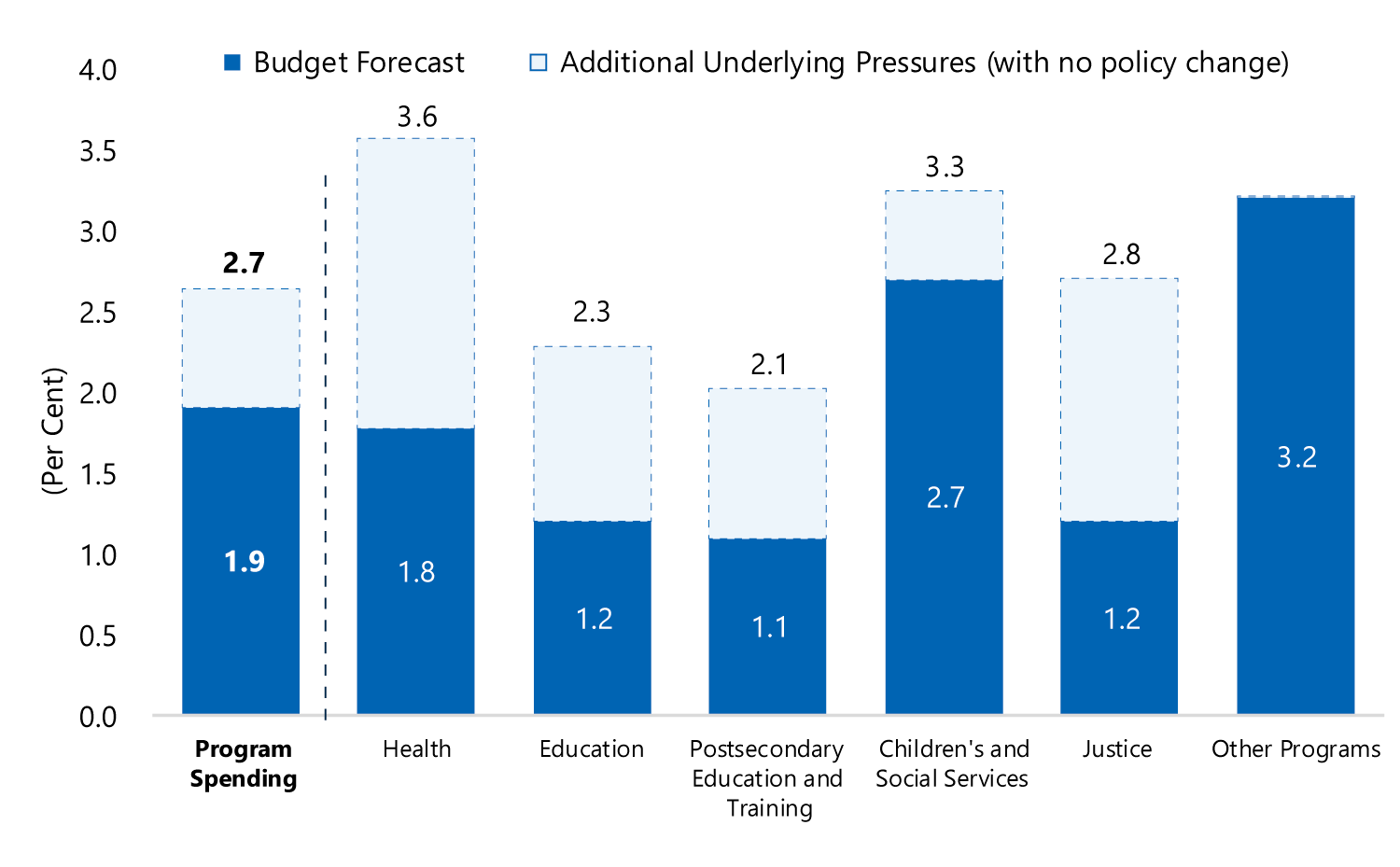
Note: Other programs growth rate exclude the $1.9 billion impact from the elimination of the Ontario Clean Energy Benefit and the expiring funding for the Pan Am Games.
Source: Ontario Ministry of Finance and FAO
The government’s plans to restrain spending are occurring across most program areas, notably in the health, education and justice sectors, where planned spending growth is about half the rate of growth in underlying spending pressures.[25]
The FAO estimates that by 2018-19, there would be about $4.0 billion in spending pressures to maintain the quality and nature of public services provided in 2015, assuming no further action by the government.
Spending Pressures and Planned Program Spending
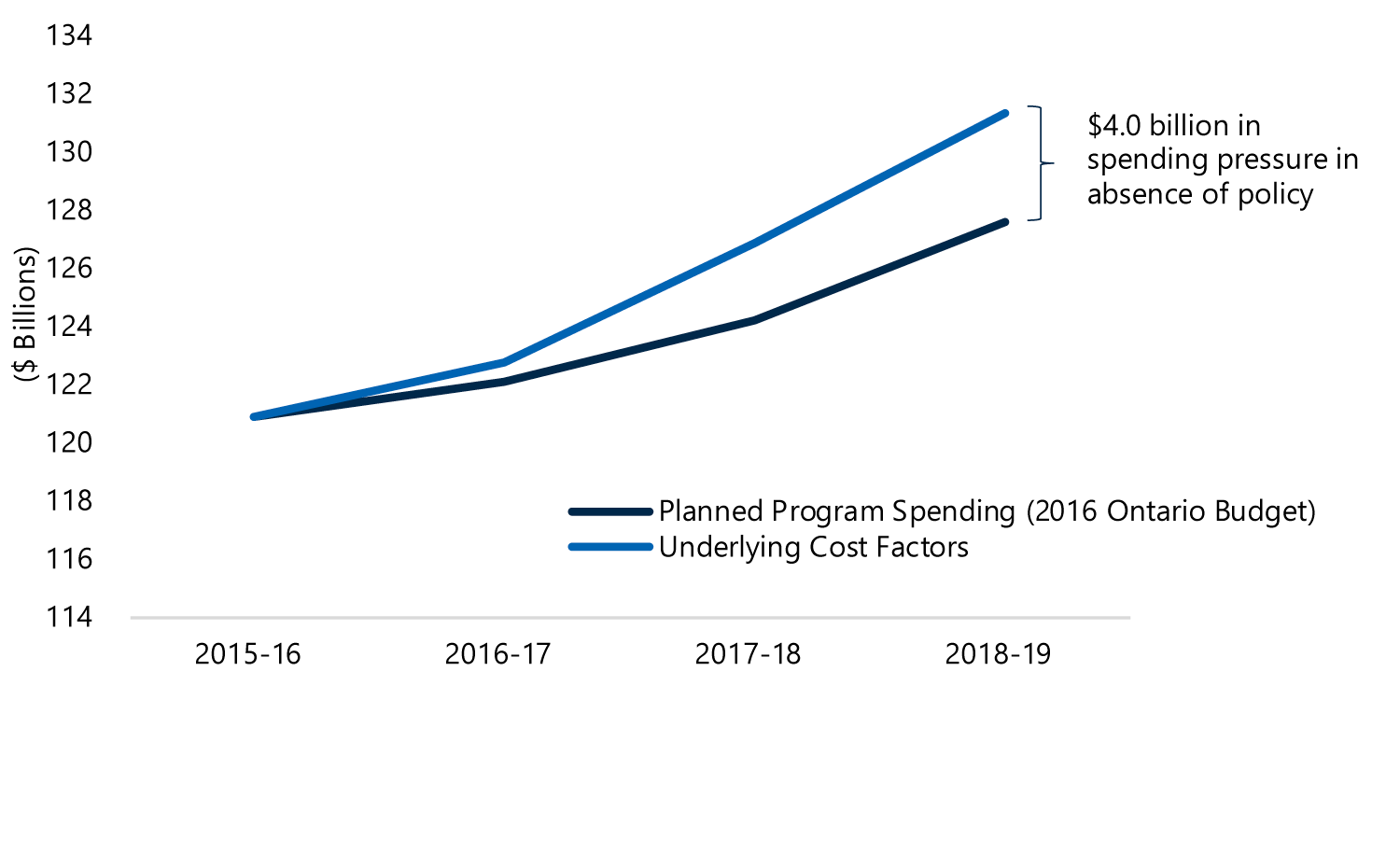
Source: Ontario Ministry of Finance and FAO
However, a number of strategies are available to governments to manage the growth in public sector spending, including:
- improving the efficiency of public service delivery;
- temporary cuts to planned spending (such as wage restraint or postponing maintenance);
- eliminating selected public services; and
- allowing the quality of existing services to deteriorate.
The Ontario government has announced a number of initiatives to reform its existing programs, which either increase the efficiency or change the scope of services. However, it is unclear to what extent the Province will rely on these various strategies to achieve its spending targets and what the implications will be for public services. Given the lack of disclosure on detailed measures to achieve the plan, there are significant risks to the government’s plan to restrain program spending.[26]
Beyond the 2016 budget’s forecast horizon, the FAO projects program spending growth of 3.4 per cent per year on average, reflecting underlying spending pressures including population growth, aging, and the rate of inflation.
Outlook for Ontario Total Expense
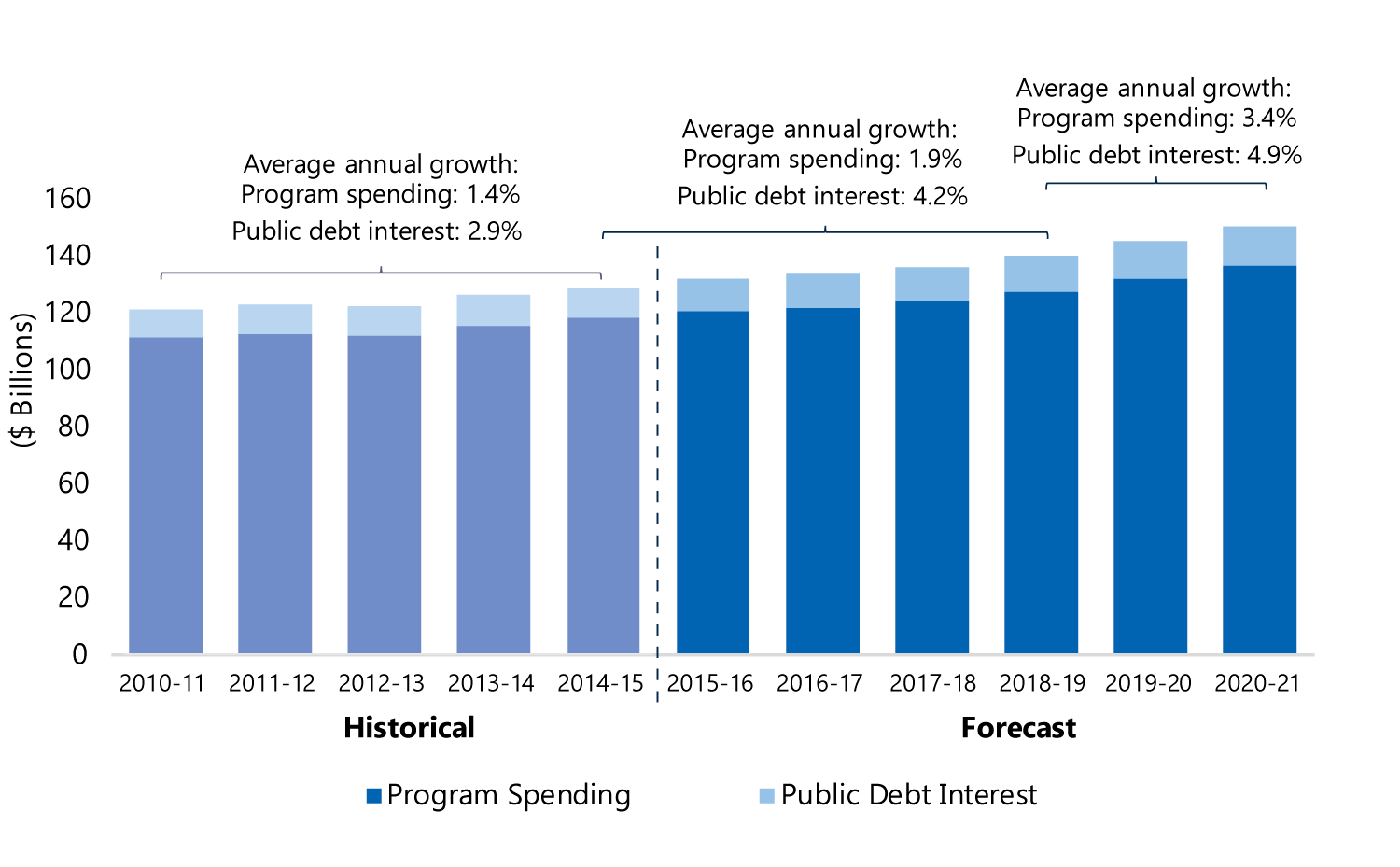
Source: Ontario Ministry of Finance and FAO
Over the 2019-20 and 2020-21 period, the FAO outlook assumes that program spending growth will increase moderately in response to underlying spending pressures. In particular:
- Population growth and aging, combined with rising service costs are expected to increase growth in health care spending (see Appendix B).
- Increases in the school-age population beyond 2017 are expected to increase education spending.
- Postsecondary education and training spending is expected to increase modestly reflecting rising costs per student which are partially offset by lower enrolment.
- Spending on children’s and social services will increase reflecting the rising cost of delivering social services and growth in the youth population.
- Justice sector spending is projected to grow moderately as higher service costs are offset by expected lower crime rates.
Interest on Debt
Over the last four years, interest on debt payments grew at an annual average rate of 2.9 per cent. The FAO projects interest on debt payments will grow at an average rate of 4.2 per cent from 2014-15 to 2018-19, increasing to 4.9 per cent per year over 2019-20 and 2020-21.
The rising pace of growth in interest on debt payments reflects the Province’s increasing debt and higher interest rates.
Fiscal Policy Levers
Although the FAO forecast projects a small deficit in 2017-18 and on-going deficits over the outlook, the government has a number of policy levers that could still result in the achievement of its fiscal targets.
Public Asset Sales Target
In the 2016 Budget, the Province confirmed its target for asset sales of $5.7 billion over 10 years. Given the current price of Hydro One shares, the FAO estimates that the Province will receive approximately $4.6 billion from the sale of 60 per cent of the company.[27]
Estimated Asset Sales Revenue
|
|
$ Billions |
|---|---|
|
GM Shares |
1.3 |
|
Hydro One |
4.6 |
|
LCBO Headquarters |
0.2 |
|
OPG Headquarters |
TBD |
|
Seaton Lands |
TBD |
|
Lakeview Lands |
TBD |
|
Total |
6.1+ |
|
2016 Budget Asset Sales Target |
5.7 |
Source: Ontario Ministry of Finance and FAO
In total, the sale of GM shares, Hydro One and LCBO headquarters are expected to generate $6.1 billion in revenue – $0.4 billion higher than the government’s target. The Province intends to sell additional public assets that would result in the government’s asset sales target being further exceeded.
The Allocation of New Revenues
The government’s projection includes $1.9 billion in new revenue from the sale of cap-and-trade permits that is to be used to fund greenhouse gas emissions reduction initiatives. Additionally, the government projections assume $1.3 billion in new funding for federal commitments for infrastructure, home care and labour-market training programs. Until additional program details are available, it is unclear how these initiatives will impact the fiscal plan.
It is possible that these new revenue streams will fund entirely new spending initiatives that were not included in previous budgets. In this case, there may be no impact on the current fiscal plan.
Alternatively, the government could allocate these new revenues to fund spending commitments that were previously included in the fiscal plan. For example:
- a previously announced hospital renovation might be eligible to be funded from cap-and-trade proceeds if the project reduces greenhouse gas emissions; or
- new federal transfers could fund public transit projects that were in the previous expense plans.
Under these circumstances, where new revenues are used to fund existing spending commitments, the budget balance would be improved.
In addition, the government could book revenue and expenses at different times, resulting in a positive impact on the budget balance. For example, expenses associated with provincial infrastructure would be amortized over the life of the asset, while cap-and-trade revenue would be recorded immediately. This would improve the budget balance in the short term, while adding annual expenses in the future.
The FAO is currently investigating the impact of the cap-and-trade program on the Province’s fiscal position.
Contingency Fund
In the 2016 Budget, the Province doubled its contingency funds to $1.2 billion for 2016-17.[28] Contingency funds are used to “protect the fiscal outlook against adverse changes in the Province’s revenue and expense”.[29] The contingency fund is in addition to the $1.0 billion reserve, resulting in a relatively large prudence factor built into the fiscal plan for 2016-17.
These funds could be used to address unforeseen expenses such as forest fires or meet unplanned additional spending commitments from new federal funding, or be transferred to ministries to fund spending pressures without affecting the fiscal plan. Any unused portion of the contingency fund would improve the government’s budget balance.
Economic Risk Assessment
The FAO’s economic forecast is largely consistent with the consensus outlook of private sector economists who expect generally solid growth in Ontario over the next several years. This expectation of relatively strong economic growth for Ontario reflects a resurgence of exports and business investment along with steady gains in household spending. This outlook is consistent with the expectation that the U.S. economy will remain robust while the Canadian dollar will remain competitively valued, helping to support Ontario exporters.
However, there are significant risks to this consensus outlook, as outlined in the Economic Outlook section of this report.
In addition, it is important to note that over the past five or six years, the consensus economic outlook has consistently over-estimated the growth in Ontario’s nominal GDP.
Forecast and Actual Ontario Nominal GDP Growth
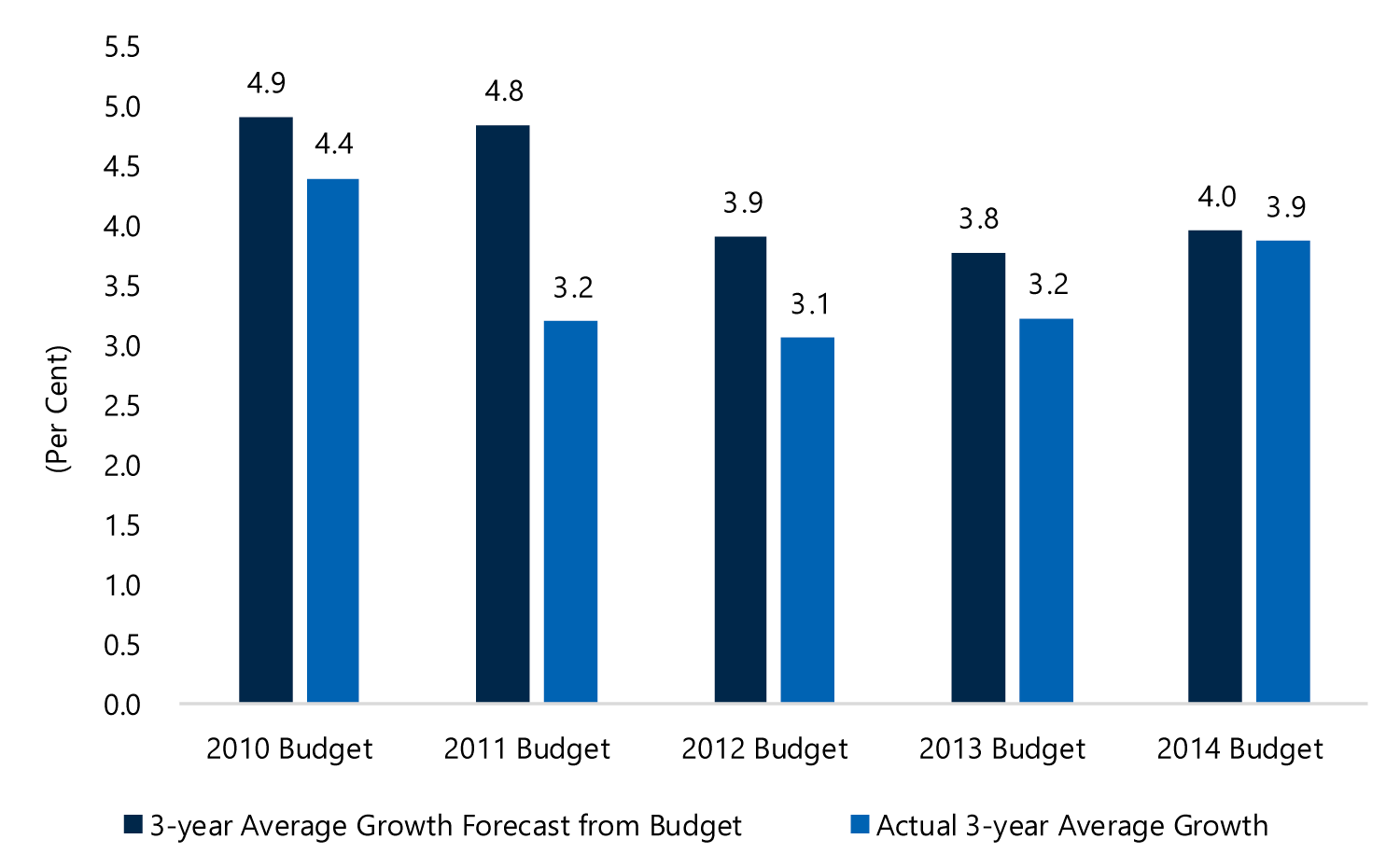
Notes: For example, the 3-year average forecast from the 2012 budget includes the forecast for 2012, 2013, and 2014. The 2014 Budget forecast includes two years of available actual history. The 2015 and 2016 budgets are not included since actual data are not yet available.
Source: Statistics Canada, Ontario Ministry of Finance and FAO
On average, the economic forecasts included in Ontario Budgets over the past five years have overestimated actual annual nominal GDP growth by 0.7 percentage points over the first three years of each budget forecast.
Over-estimating actual economic growth has been a common feature of most economic forecasts over the past five or six years, both in Canada and abroad. Economists continue to debate the reasons behind these forecast disappointments.[30]
Assessing the Impact of Moderate Economic Growth
Lower than expected economic growth would pose a significant risk for the Province’s commitment to balance the budget and reduce the debt burden. To assess the fiscal risk of somewhat slower economic growth, the FAO created a ‘moderate growth scenario’ in which the economy maintains the pace of growth of the past five years over the outlook. Specifically, the growth in nominal GDP is assumed to average 3.5 per cent from 2016-2020, equal to the average growth from 2011 to 2015, but 0.5 per cent lower than the 4.0 per cent average growth in the FAO forecast.[31]
Nominal GDP in FAO Outlook and Moderate Growth Scenario
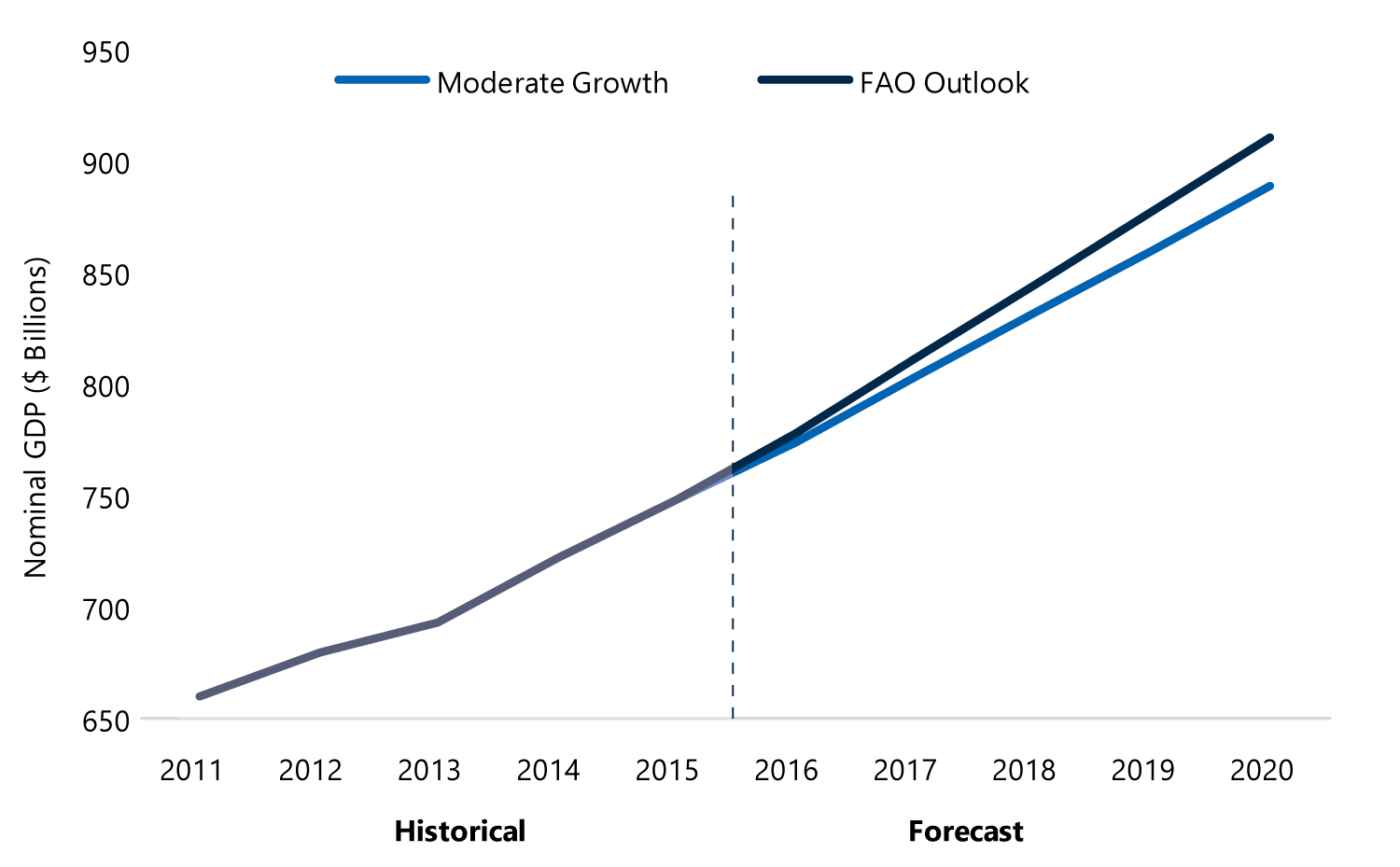
Source: Statistics Canada and FAO
Key economic variables – labour income, corporate profits, household spending and real GDP growth - were adjusted to be consistent with the assumption of 0.5 percentage point lower average nominal GDP growth.
Moderately slower growth in revenue drivers leads to $800 million in lower revenue by 2017-18, and $2.1 billion lower by 2020-21 relative to the FAO outlook.[32]
Consistent with the FAO base case outlook, this moderate growth scenario adopts the government’s outlook for program spending through 2018-19, and assumes that program spending rises at a pace consistent with underlying demographic and cost pressures over the final two years of the outlook.
Under these assumptions, and in the absence of additional fiscal policy measures, the FAO estimates that the budget deficit would be $1.4 billion in 2017-18 and grow to $3.5 billion by 2020-21.
Ontario’s Budget Balance Under Alternative Economic Outlooks
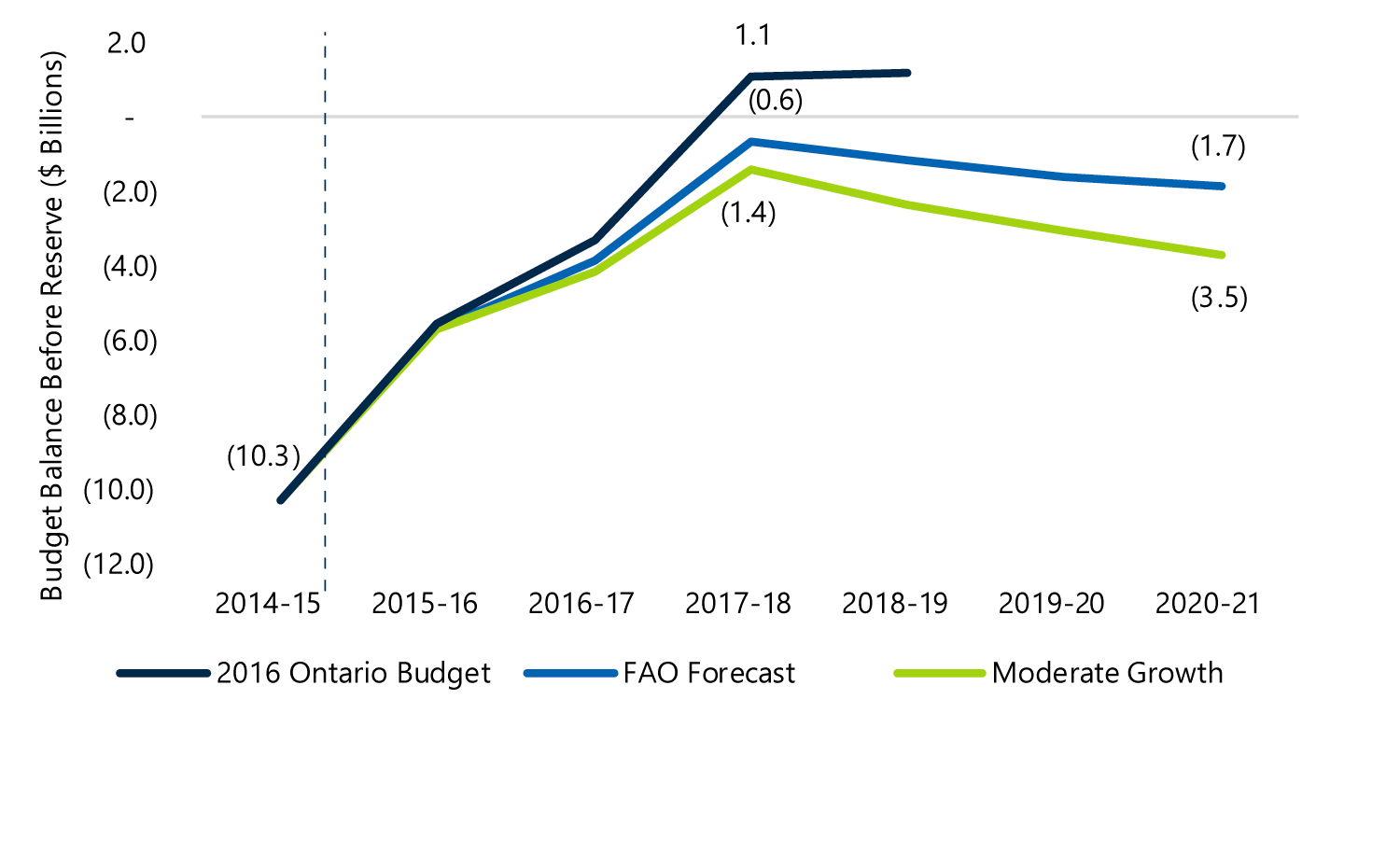
Source: Ontario Ministry of Finance and FAO
This scenario demonstrates that even a moderate underperformance of the Ontario economy would represent a challenge for the government’s fiscal plan, likely requiring new fiscal policies to address the growing budget deficit.
4. Ontario Debt Outlook
Overview
Ontario Net Debt to Rise by Over $50 Billion
The Province’s net debt[33] is expected to reach $296.3 billion in 2015-16, up $11.7 billion from 2014-15, the smallest annual increase in Ontario’s net debt since 2007-08.
From 2015-16 to 2020-21, Ontario’s net debt is projected to rise by $53.9 billion to $350.2 billion. Over this same five-year period, the FAO projects that the Province will incur deficits totaling $8.8 billion.[34]
Change in Net Debt Exceeds Total Deficits over Outlook*
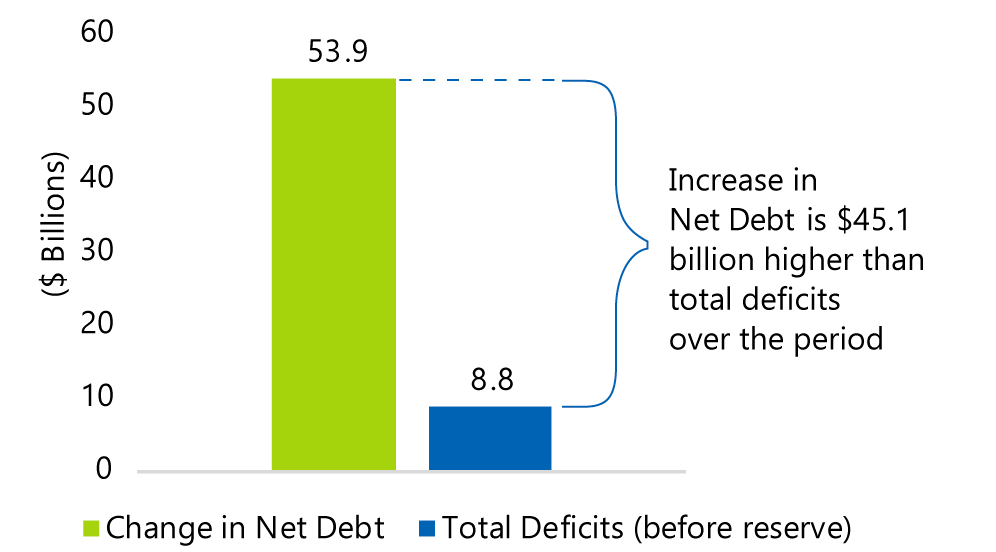
* Outlook is 2015-16 to 2020-21
Source: Ontario Ministry of Finance and FAO
The rise in net debt is much larger than the amount required to finance the expected budget deficits over the outlook. This is because the increase in net debt includes the total amount of cash required in a year to purchase new capital assets, while the deficit only includes the relatively smaller amount for amortization on the current stock of public assets.[35]
Ontario’s Debt Burden
The Province’s net debt relative to GDP increased sharply from 26.0 per cent in 2007-08 to a peak of 39.6 per cent in 2015-16. The FAO projects the net debt-to-GDP ratio will gradually decrease to 38.4 per cent by 2020-21, a decline of approximately one percentage point over five years.
In the 2016 Budget, the Province restated its commitment to reduce the net debt-to-GDP ratio to 27 per cent, approximately 11 percentage points below the projected value of the ratio in 2020-21. The Government has not provided details of how or when it plans to achieve this commitment.
Ontario’s Net Debt Forecast to Rise
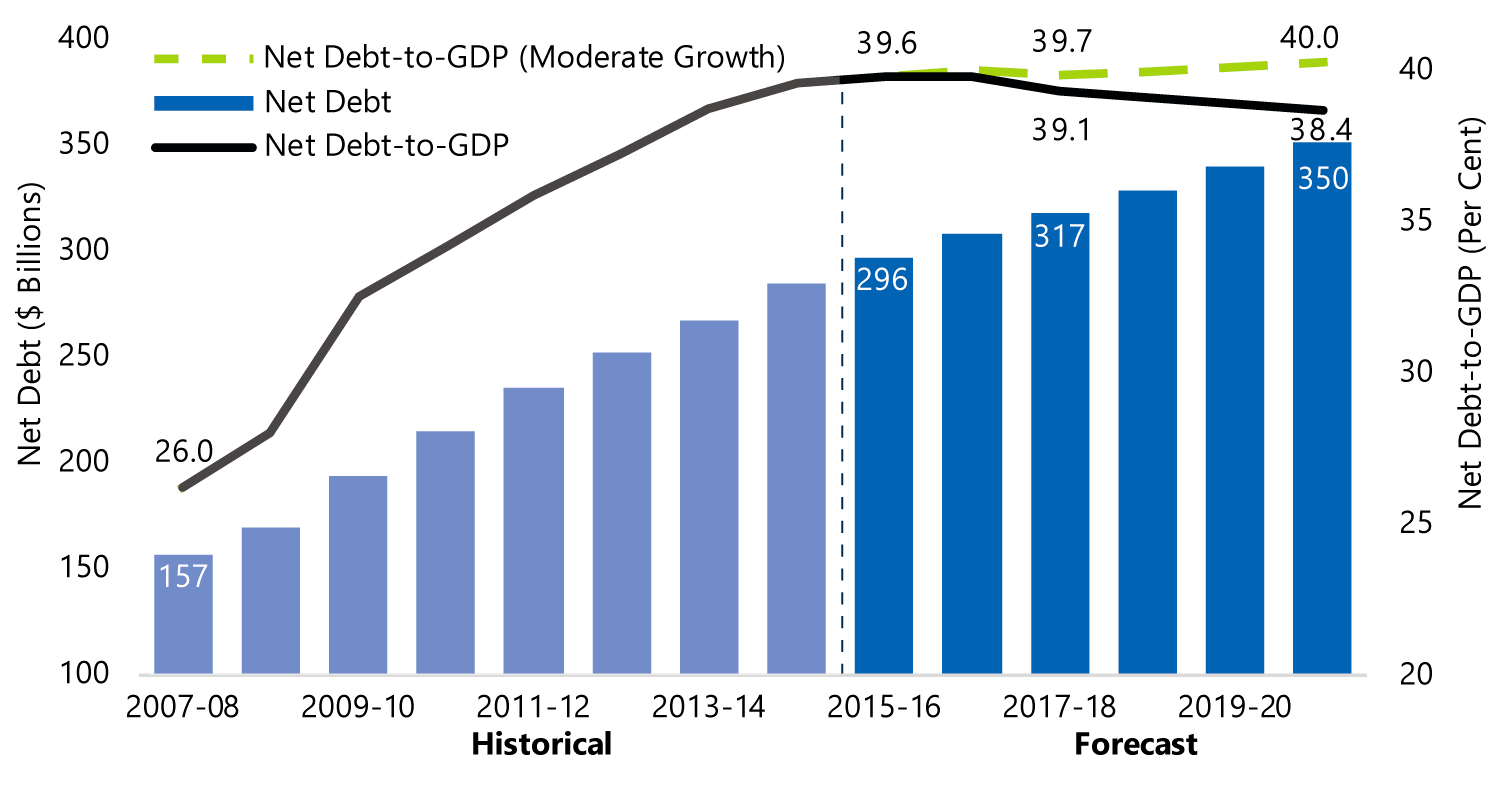
Source: Ontario Public Accounts and FAO
The Province’s commitment to reduce the net debt-to-GDP ratio will be more challenging if economic growth were to underperform compared to expectations. Under the FAO scenario of somewhat more moderate economic growth (described
in the previous section), the net-debt to-GDP ratio does not gradually improve over the outlook, but instead edges up to 40 per cent by 2020-21. This increase in the net debt-to-GDP ratio reflects both a lower level of nominal GDP under this scenario, as well as a higher level of debt.
Ontario’s Borrowing Requirements
Each year, the Province borrows from Canadian and international capital markets to cover any shortfall of current revenues over spending (on a cash basis), finance new investments in capital assets and to refinance past borrowing that has matured.
The Province’s borrowing requirement in 2015-16 was $31.9 billion. These funds are required largely to cover the cash shortfall resulting from the $5.7 billion deficit, $8.5 billion of investments in capital assets and $21.1 billion in previous debt that matured during the year. In 2016-17, the Province’s borrowing requirement is expected to edge down slightly to $30.0 billion.[36]
Despite smaller projected deficits, Ontario’s total borrowing requirements are expected to remain elevated over the outlook, averaging $29.0 billion per year, reflecting the Province’s cash requirements to finance the large infrastructure program as well as the need to refinance the steady roll-over of maturing debt issues.
Ontario’s Borrowing Requirements and Budget Balance

Source: Ontario Public Accounts, 2016 Ontario Budget and FAO
Given the Province’s relatively high level of debt and its elevated annual borrowing requirements, Ontario’s fiscal plan would be negatively impacted if the Province’s borrowing costs were to rise more than expected or its access to capital markets was temporarily disrupted.
The Province has a conservative approach to managing its borrowing program and its exposure to changes in interest rates that limits the possibility of a sudden increase in debt service costs. In particular, the Province has taken advantage of historically low interest rates by extending the maturity of its debt from eight years in 2009-10 to 14 years in 2015-16.
Moreover, as part of its debt management policy, Ontario manages the risk associated with its large borrowing program by maintaining access to diverse domestic and international capital markets for its debt issues and by maintaining prudent levels of cash and liquid investments.
5. Appendices
Appendix A: Data Tables
Economic Outlook
Table 1: Outlook for Ontario GDP and Key Revenue Drivers
|
(Per Cent Growth) |
2014a |
2015 |
2016f |
2017f |
2018f |
2019f |
2020f |
Average* |
|---|---|---|---|---|---|---|---|---|
|
Real GDP |
||||||||
|
FAO |
2.7 |
2.6a |
2.5 |
2.5 |
2.3 |
2.2 |
2.0 |
2.4 |
|
Budget 2016 |
2.7 |
2.5f |
2.2 |
2.4 |
2.2 |
2.0 |
- |
2.2 |
|
Nominal GDP |
||||||||
|
FAO |
4.1 |
3.6a |
4.2 |
4.2 |
4.1 |
3.9 |
3.8 |
4.1 |
|
Budget 2016 |
4.1 |
3.6f |
4.0 |
4.6 |
4.2 |
4.0 |
- |
4.2 |
|
Labour Income** |
||||||||
|
FAO |
3.3 |
3.7a |
4.0 |
3.9 |
4.1 |
4.2 |
3.9 |
4.1 |
|
Budget 2016 |
3.4 |
3.3f |
4.4 |
4.5 |
4.5 |
4.4 |
- |
4.5 |
|
Corporate Profits |
||||||||
|
FAO |
12.7 |
3.1a |
3.4 |
6.9 |
5.3 |
3.2 |
3.5 |
4.7 |
|
Budget 2016 |
12.7 |
2.1f |
3.7 |
8.5 |
5.7 |
3.9 |
- |
5.5 |
|
Household Consumption |
||||||||
|
FAO |
4.6 |
4.3a |
4.2 |
3.8 |
3.4 |
3.4 |
3.4 |
3.7 |
|
Budget 2016*** |
5.0 |
4.7f |
4.8 |
3.7 |
3.4 |
3.2 |
- |
3.8 |
f = Forecast a= Actual
* For comparison purposes, average is calculated from 2016 to 2019.
** FAO labour income figures are presented on a domestic basis while the budget reports on a national basis.
*** 2016 Ontario Budget Household Consumption is Retail Sales.
Source: Statistics Canada, 2016 Ontario Budget, Ontario Economic Accounts and FAO
Table 2: Outlook for Selected Economic Indicators
|
2014a |
2015a |
2016f |
2017f |
2018f |
2019f |
2020f |
|
|---|---|---|---|---|---|---|---|
|
Employment (Per Cent Growth) |
|||||||
|
FAO |
0.8 |
0.7 |
1.2 |
1.4 |
1.1 |
1.1 |
0.9 |
|
Budget 2016 |
0.8 |
0.7 |
1.1 |
1.2 |
1.2 |
1.1 |
- |
|
CPI Inflation (Per Cent Growth) |
|||||||
|
FAO |
2.4 |
1.2 |
1.5 |
2.0 |
2.0 |
2.0 |
1.9 |
|
Budget 2016 |
2.4 |
1.2 |
1.8 |
2.0 |
2.0 |
2.0 |
- |
|
Canada Real GDP (Per Cent Growth) |
|||||||
|
FAO |
2.5 |
1.2 |
1.7 |
2.4 |
2.3 |
2.1 |
2.0 |
|
Budget 2016 |
- |
- |
- |
- |
- |
- |
- |
|
U.S. Real GDP (Per Cent Growth) |
|||||||
|
FAO |
2.4 |
2.4 |
2.2 |
2.1 |
2.0 |
- |
- |
|
Budget 2016 |
2.4 |
2.4 |
2.1 |
2.4 |
2.4 |
2.2 |
- |
|
Canadian Dollar (Cents US) |
|||||||
|
FAO |
90.5 |
78.2 |
74.0 |
75.0 |
79.0 |
81.0 |
81.0 |
|
Budget 2016 |
90.5 |
78.2 |
72.0 |
75.5 |
81.0 |
83.0 |
- |
|
WTI Crude Oil (US$) |
|||||||
|
FAO |
93 |
49 |
37 |
44 |
51 |
55 |
59 |
|
Budget 2016 |
93 |
49 |
42 |
53 |
60 |
67 |
- |
|
Three-month Treasury Bill Rate (Per Cent) |
|||||||
|
FAO |
0.9 |
0.5 |
0.5 |
1.2 |
2.2 |
2.9 |
3.3 |
|
Budget 2016 |
0.9 |
0.5 |
0.5 |
0.8 |
2.2 |
2.8 |
- |
|
10-year Government Bond Rate (Per Cent) |
|||||||
|
FAO |
2.2 |
1.5 |
1.4 |
2.3 |
3.3 |
4.1 |
4.5 |
|
Budget 2016 |
2.2 |
1.5 |
1.6 |
2.3 |
3.3 |
3.6 |
- |
f = Forecast a= Actual
Source: Statistics Canada, 2016 Ontario Budget, Federal Open Market Committee, Bank of Canada, Energy Information Administration and FAO
Table 3: Private-Sector Forecasts of Ontario
|
(Per Cent Growth) |
2015 |
2016f |
2017f |
2018f |
2019f |
2020f |
|---|---|---|---|---|---|---|
|
Real GDP |
||||||
|
FAO Forecast |
2.6a |
2.5 |
2.5 |
2.3 |
2.2 |
2.0 |
|
FAO Forecaster Average |
2.4f |
2.4 |
2.5 |
2.3 |
2.2 |
2.0 |
|
Conference Board of Canada |
2.4f |
2.4 |
2.4 |
2.1 |
2.1 |
2.2 |
|
Centre for Spatial Economics |
2.4f |
2.4 |
2.6 |
2.2 |
2.2 |
1.7 |
|
Policy and Economic Analysis Program |
2.5f |
2.4 |
2.7 |
2.7 |
2.2 |
2.0 |
|
Private Sector Average* |
2.5f |
2.4 |
2.5 |
2.3 |
2.2 |
- |
|
MOF - 2016 Budget |
2.5f |
2.2 |
2.4 |
2.2 |
2.0 |
- |
|
Nominal GDP |
||||||
|
FAO Forecast |
3.6a |
4.2 |
4.2 |
4.1 |
3.9 |
3.8 |
|
Forecaster Average |
3.5f |
4.3 |
4.2 |
4.1 |
3.9 |
3.8 |
|
Conference Board of Canada |
3.5f |
4.2 |
4.1 |
4.0 |
3.8 |
4.0 |
|
Centre for Spatial Economics |
3.5f |
4.4 |
4.0 |
3.6 |
3.9 |
3.4 |
|
Policy and Economic Analysis Program |
3.5f |
4.1 |
4.6 |
4.7 |
4.1 |
3.9 |
|
Private Sector Average* |
3.6f |
4.2 |
4.5 |
4.3 |
4.3 |
- |
|
MOF - 2016 Budget |
3.6f |
4.0 |
4.6 |
4.2 |
4.0 |
- |
f = Forecast, a = Actual
Note: The 2016 Ontario Budget forecast as well as private sector forecasts were prepared prior to the release of the 2015 fourth quarter Ontario Economic Accounts which provided the first estimate of Ontario’s actual economic growth in 2015.
* Private-Sector Average includes Conference Board, Global Insight, C4SE, PEAP, RBC, Scotia Bank, TD Bank, Desjardins, BMO, CIBC, Central 1, Laurentian and National Bank.
Source: 2016 Ontario Budget, Ontario Ministry of Finance Consensus (as of April 15, 2016) and FAO
Fiscal Outlook
Table 4: FAO Summary Fiscal Outlook
|
($ Billions) |
a2014-15 |
f2015-16 |
f2016-17 |
f2017-18 |
f2018-19 |
f2019-20 |
f2020-21 |
|---|---|---|---|---|---|---|---|
|
Revenue |
118.5 |
126.4 |
129.7 |
135.7 |
139.1 |
143.6 |
148.6 |
|
Expense |
128.9 |
132.1 |
133.7 |
136.3 |
140.1 |
145.1 |
150.3 |
|
Programs |
118.2 |
120.9 |
122.1 |
124.2 |
127.6 |
132.0 |
136.5 |
|
Interest on Debt |
10.6 |
11.2 |
11.6 |
12.1 |
12.5 |
13.1 |
13.8 |
|
Surplus/Deficit Before Reserve |
-10.3 |
-5.7 |
-4.0 |
-0.6 |
-1.1 |
-1.5 |
-1.7 |
f = Forecast a= Actual
Source: 2016 Ontario Budget and FAO
Table 5: FAO Revenue Outlook
|
($ Billions)th |
a2014-15 |
f2015-16 |
f2016-17 |
f2017-18 |
f2018-19 |
f2019-20 |
f2020-21 |
|---|---|---|---|---|---|---|---|
|
Revenue |
|||||||
|
Personal Income Tax |
29.3 |
30.4 |
32.1 |
33.7 |
35.6 |
37.5 |
39.3 |
|
Sales Tax |
21.7 |
23.4 |
23.6 |
24.3 |
25.0 |
25.8 |
26.6 |
|
Corporations Tax |
9.6 |
11.2 |
11.9 |
12.4 |
12.9 |
13.2 |
13.5 |
|
All Other Taxes |
21.7 |
25.6 |
23.5 |
24.2 |
25.0 |
25.7 |
26.4 |
|
Total Taxation Revenue |
82.3 |
90.6 |
91.1 |
94.6 |
98.5 |
102.1 |
105.8 |
|
Transfers from Government |
21.6 |
22.9 |
24.6 |
25.4 |
25.9 |
26.6 |
27.4 |
|
Income from Government |
5.6 |
4.3 |
4.9 |
5.1 |
5.3 |
5.5 |
5.7 |
|
Other Non-Tax Revenue |
9.0 |
8.6 |
9.1 |
10.6 |
9.4 |
9.4 |
9.6 |
|
Total Revenue |
118.5 |
126.4 |
129.7 |
135.7 |
139.1 |
143.6 |
148.6 |
f = Forecast a= Actual
Source: 2016 Ontario Budget and FAO
Table 6: FAO Expense Outlook
|
($ Billions) |
a2014-15 |
f2015-16 |
f2016-17 |
f2017-18 |
f2018-19 |
f2019-20 |
f2020-21 |
|---|---|---|---|---|---|---|---|
|
Programs |
|||||||
|
Health |
50.0 |
50.8 |
51.8 |
52.8 |
53.7 |
55.8 |
57.8 |
|
Education |
24.6 |
24.8 |
25.6 |
25.8 |
25.9 |
26.8 |
27.9 |
|
Postsecondary and Training |
7.7 |
7.8 |
7.9 |
7.9 |
8.0 |
8.2 |
8.3 |
|
Children's and Social Services |
14.7 |
15.6 |
15.8 |
16.1 |
16.3 |
16.8 |
17.2 |
|
Justice |
4.4 |
4.5 |
4.5 |
4.5 |
4.6 |
4.8 |
4.9 |
|
Other Programs |
16.9 |
17.5 |
16.5 |
17.2 |
19.1 |
19.7 |
20.3 |
|
Total Program |
118.2 |
120.9 |
122.1 |
124.2 |
127.6 |
132.0 |
136.5 |
|
Interest on Debt |
10.6 |
11.2 |
11.6 |
12.1 |
12.5 |
13.1 |
13.8 |
|
Total Expense |
128.9 |
132.1 |
133.7 |
136.3 |
140.1 |
145.1 |
150.3 |
f = Forecast a= Actual
Source: 2016 Ontario Budget and FAO
Table 7: Ontario’s Debt
|
th($ Billions) |
a2014-15 |
f2015-16 |
f2016-17 |
f2017-18 |
f2018-19 |
f2019-20 |
f2020-21 |
|---|---|---|---|---|---|---|---|
|
Surplus/Deficit Before Reserve |
-10.3 |
-5.7 |
-4.0 |
-0.6 |
-1.1 |
-1.5 |
-1.7 |
|
Accumulated Deficit |
187.5 |
193.4 |
197.4 |
198.0 |
199.0 |
200.5 |
202.3 |
|
Gross Debt |
315.0 |
325.3 |
330.8 |
337.0 |
344.6 |
352.3 |
359.6 |
|
Net Debt |
284.6 |
296.3 |
308.2 |
317.4 |
328.3 |
339.4 |
350.2 |
|
Change in Net Debt |
17.4 |
11.7 |
11.9 |
9.2 |
11.0 |
11.0 |
10.8 |
|
Net Debt as a Per Cent of GDP |
39.4% |
39.6% |
39.5% |
39.1% |
38.8% |
38.6% |
38.4% |
f = Forecast a= Actual
Source: 2016 Ontario Budget and FAO
Table 8: FAO Forecast and Moderate Growth Scenario - Key Fiscal Comparisons
|
($ Billions) |
a2014-15 |
f2015-16 |
f2016-17 |
f2017-18 |
f2018-19 |
f2019-20 |
f2020-21 |
|---|---|---|---|---|---|---|---|
|
Revenue |
|||||||
|
FAO Forecast |
118.5 |
126.4 |
129.7 |
135.7 |
139.1 |
143.6 |
148.6 |
|
FAO Moderate Growth Scenario |
118.5 |
126.4 |
129.4 |
134.9 |
137.9 |
142.0 |
146.5 |
|
Difference |
0.0 |
0.0 |
-0.3 |
-0.8 |
-1.2 |
-1.7 |
-2.1 |
|
Total Expense |
|||||||
|
FAO Forecast |
128.9 |
132.1 |
133.7 |
136.3 |
140.1 |
145.1 |
150.3 |
|
FAO Moderate Growth Scenario |
128.9 |
132.1 |
133.7 |
136.3 |
140.1 |
144.9 |
150.0 |
|
Difference |
0.0 |
0.0 |
0.1 |
0.0 |
0.0 |
-0.2 |
-0.3 |
|
Surplus (Deficit) Before Reserve |
|||||||
|
FAO Forecast |
-10.3 |
-5.7 |
-4.0 |
-0.6 |
-1.1 |
-1.5 |
-1.7 |
|
FAO Moderate Growth Scenario |
-10.3 |
-5.7 |
-4.3 |
-1.4 |
-2.3 |
-2.9 |
-3.5 |
|
Difference |
0.0 |
0.0 |
-0.4 |
-0.8 |
-1.2 |
-1.4 |
-1.8 |
f = Forecast a= Actual
Source: 2016 Ontario Budget and FAO
Appendix B: Health Care Spending
The growth of health care spending reflects rising per capita costs, demographic factors and policy decisions (such as what health care services will be funded by the Province).
Provincial health spending grew by 7.2 per cent on average annually from 2005-06 to 2009-10. Following the financial crisis, the Province limited health spending growth to 3.1 per cent per year from 2009-10 to 2014-15 period. According to the 2016 Budget, the government plans to further limit health spending growth to just 1.8 per cent per year from 2014-15 to 2018-19, below the already restrained pace of growth of the past five years.
Historical and Planned Growth in Health Care Spending
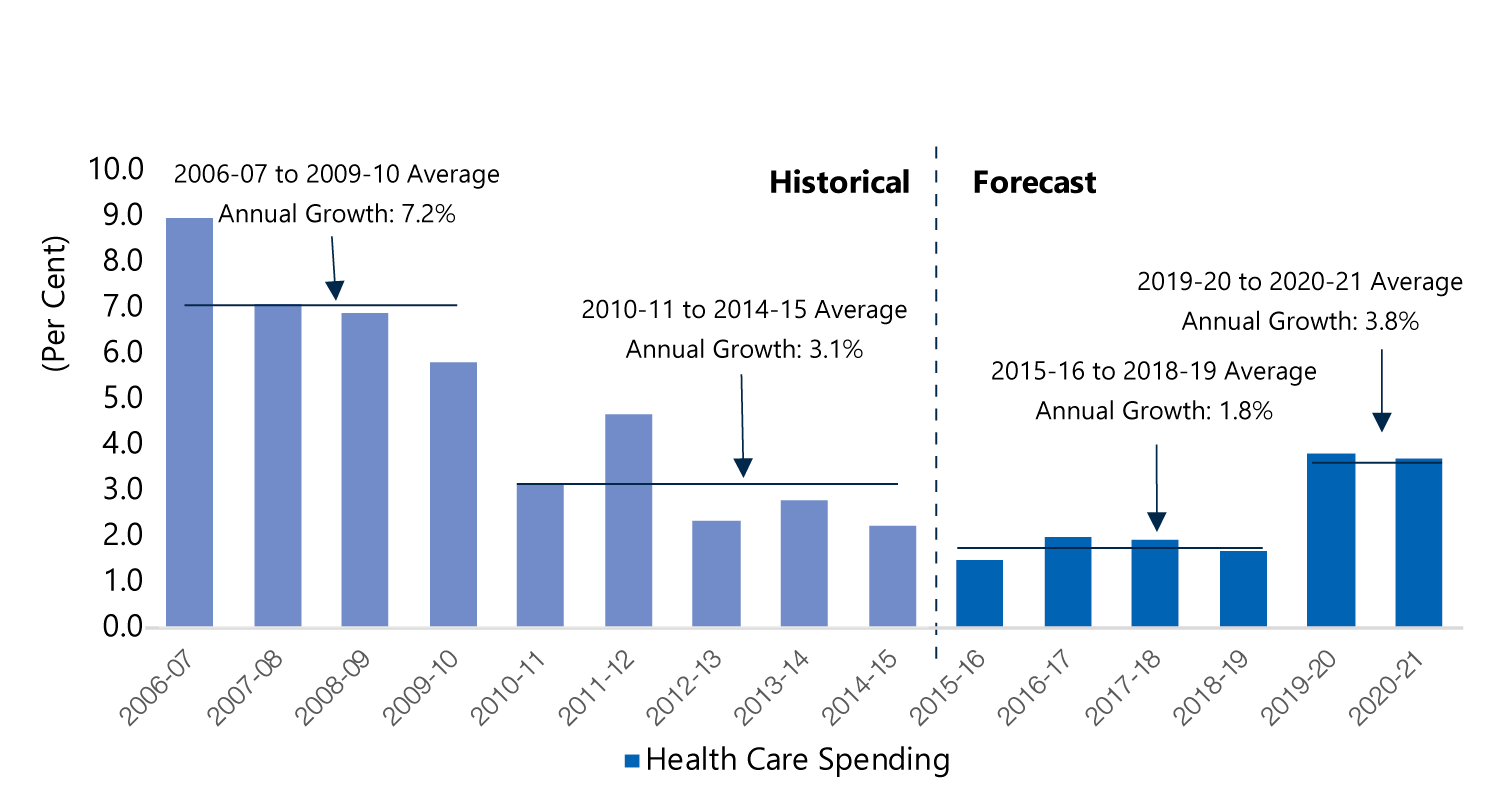
Source: FAO, Statistics Canada, Canadian Institute for Health Information and Ontario Ministry of Finance
Assuming that the quality and type of health care services provided in 2015 remains the same over the outlook, the FAO estimates that population growth and aging would contribute 2.2 percentage points per year on average to the growth in health spending. A stronger economy, which leads to higher incomes and price inflation would contribute a further 3.0 percentage points. Combined, these factors would lead to 5.2 per cent annual growth in health spending.
Contributions to Growth in Health Spending
Note: Income/wealth and inflation effects are calculated as a three-year moving average.
Source: FAO, Statistics Canada, Canadian Institute for Health Information, and Ontario Ministry of Finance
Given these factors, it is unclear how the government will achieve its target of 1.8 per cent annual spending increases over the next four years.
By 2018-19, spending restraint in the health care sector will have spanned nine-years, longer than the period of spending restraint in the mid-1990s. As a result, the FAO outlook assumes that the government will be required to increase the pace of health care spending after 2018-19 to an average annual increase of 3.8 per cent, a rate still below the underlying growth in demand and costs. This increase in the average pace of spending growth is similar to what occurred following previous periods of spending restraint.
The FAO is undertaking a review of the medium-term outlook for health sector spending, including the government’s planned measures to manage the growth of health care spending.
Appendix C: The FAO’s Fiscal Outlook Model for Ontario
The FAO has developed a forecasting model[37] of the Ontario government’s fiscal position, which can be used to produce budget forecasts given an economic outlook and demographic projection.
The fiscal model will be an integral tool in the FAO’s assessment of the state of the government’s finances. The model provides a consistent framework to evaluate the impact of economic and demographic conditions as well as planned or proposed policy initiatives.
The model is divided into three separate blocks of equations covering provincial revenues, expenses, and debt.
Revenues
The revenue portion of the model covers the four major categories of revenue: taxation, transfers from the federal government, income from government business enterprises and ‘other non-tax revenue’. Revenues from government business enterprises, non-tax revenue, as well as the six largest taxes are estimated independently based on the historical relationship (elasticity) between the revenue source and its economic drivers. Similarly, the three largest transfer payments from the federal government are modelled based on program parameters as well as the relevant economic indicators for both Ontario and the rest of Canada.
A survey of relevant research was conducted to provide independent confirmation of the appropriate historical relationships.
In addition, model-based forecasts for each revenue category are adjusted to reflect supplementary information provided in Ontario budgets, to capture new policy measures as well as other temporary or prior-year factors not reflected by the economic data.
Expenses
Government program spending is separated into each of the major expense sectors: health, education, postsecondary and training, children’s and social services, justice and other programs. These sectors are further sub-divided into separate expense items and forecast based on relationships between the program and its key economic and demographic drivers, as identified by a survey of related research.
Expense items are generally forecast based on a two-step approach. For example, education spending is estimated by projecting the per student cost of education spending based on historical growth relative to CPI inflation. Per student costs are then projected using the outlook for price inflation and combined with demographic projections of student enrolment to provide an estimate of total education spending.
This approach produces estimates of program spending by sector that reflect the historical drivers of government spending, including both cost and demographic drivers.
Interest on debt payments are modelled based on gross debt, each year’s borrowing requirements and an interest rate forecast.
Debt
The debt portion of the model is based on the standard accounting relationships between the previous year’s debt, current budget balances, and new borrowing. Estimates of the budget balance, capital expenditures, amortization, debt maturities, financial and tangible assets are used to calculate Ontario’s accumulated deficit, net borrowing requirements, and gross and net debt levels.
Appendix D: Provincial Comparisons
|
NL |
PEI |
NS |
NB |
QC |
Ontario |
MB |
SK |
AB |
BC |
|
|---|---|---|---|---|---|---|---|---|---|---|
|
Fiscal Performance (2014-15) |
||||||||||
|
Total Revenue |
||||||||||
|
Per Capita ($) |
13,164 |
11,225 |
9,961 |
10,939 |
11,688 |
8,665 |
11,548 |
12,527 |
10,988 |
9943.5 |
|
to GDP (%) |
20.8 |
27.3 |
24.0 |
25.7 |
25.9 |
16.4 |
23.1 |
17.0 |
12.1 |
19.4 |
|
Total Program Expenditures |
||||||||||
|
Per Capita ($) |
13,385 |
10,581 |
9,580 |
10,376 |
10,563 |
8,684 |
11,249 |
12,004 |
10,467 |
9,042 |
|
to GDP (%) |
21.1 |
25.8 |
23.1 |
24.4 |
23.4 |
16.5 |
22.5 |
16.3 |
11.5 |
17.7 |
|
Interest on Debt |
||||||||||
|
Per Capita ($) |
1,526 |
881 |
927 |
901 |
1,258 |
780 |
660 |
468 |
173 |
539 |
|
to GDP (%) |
2.4 |
2.1 |
2.2 |
2.1 |
2.8 |
1.5 |
1.3 |
0.6 |
0.2 |
1.1 |
|
to Revenue (%) |
11.6 |
7.9 |
9.3 |
8.2 |
10.8 |
9.0 |
5.7 |
3.7 |
1.6 |
5.4 |
|
Total Expenditures |
||||||||||
|
Per Capita ($) |
14,911 |
11,463 |
10,507 |
11,277 |
11,821 |
9,464 |
11,909 |
12,472 |
10,640 |
9,581 |
|
to GDP (%) |
23.5 |
27.9 |
25.3 |
26.5 |
26.2 |
17.9 |
23.8 |
16.9 |
11.7 |
18.7 |
|
Primary Balance |
||||||||||
|
Per Capita ($) |
-221 |
644 |
381 |
563 |
1,124 |
-19 |
299 |
523 |
521 |
901 |
|
to GDP (%) |
-0.7 |
10.7 |
1.0 |
1.8 |
0.3 |
0.0 |
0.5 |
0.6 |
0.1 |
0.4 |
|
Deficit (-) or surplus |
||||||||||
|
Level (Millions $) |
-924 |
-35 |
-144 |
-255 |
-1,097 |
-10,933 |
-424 |
62 |
1,435 |
1,683 |
|
Per Capita ($) |
-1,747 |
-237 |
-152 |
-338 |
-286 |
-799 |
-331 |
55 |
348 |
363 |
|
to GDP (%) |
-2.8 |
-0.6 |
-0.4 |
-0.8 |
-0.6 |
-1.5 |
-0.7 |
0.1 |
0.4 |
0.7 |
|
Net Debt |
||||||||||
|
Level (Millions $) |
10,260 |
2,149 |
15,031 |
12,018 |
190,402 |
284,137 |
18,775 |
5,552 |
-9,241 |
38,902 |
|
Per Capita ($) |
19,392 |
14,701 |
15,950 |
15,927 |
23,178 |
20,774 |
14,665 |
4,947 |
-2,242 |
8,387 |
|
to GDP (%) |
30.6 |
35.8 |
38.5 |
37.5 |
51.5 |
39.4 |
29.3 |
6.7 |
-2.5 |
16.4 |
|
Economic and Demographic Indicators |
||||||||||
|
Real GDP |
||||||||||
|
Average Growth (%) |
0.6 |
1.7 |
0.0 |
-0.2 |
1.4 |
2.0 |
2.5 |
3.7 |
5.1 |
2.7 |
|
Nominal GDP |
||||||||||
|
Average Growth (%) |
4.0 |
3.5 |
1.5 |
1.5 |
3.1 |
3.4 |
4.7 |
7.1 |
8.6 |
3.7 |
|
Employment |
||||||||||
|
Average Growth (%) |
1.8 |
1.5 |
-0.2 |
-0.3 |
0.8 |
1.3 |
0.7 |
1.8 |
3.0 |
0.6 |
|
Population |
||||||||||
|
Average Growth (%) |
0.3 |
0.8 |
0.0 |
0.1 |
0.9 |
1.0 |
1.2 |
1.6 |
2.5 |
1.0 |
6 | About this document
Established by the Financial Accountability Officer Act, 2013, the Financial Accountability Office (FAO) provides independent analysis on the state of the Province’s finances, trends in the provincial economy and related matters important to the Legislative Assembly of Ontario. The FAO’s Economic and Fiscal Outlook, will be released each spring and fall, providing an assessment of Ontario’s medium-term economic and fiscal outlook.
This report was prepared by Mario Angastiniotis, Edward Crummey, Luan Ngo and Nicolas Rhodes under the direction of David West. Several external reviewers provided comments on the report. The assistance of external reviewers implies no responsibility for the final report.
This report is based on information available to April 15, 2016. Background data used in this report are available upon request.
[1] Unless otherwise indicated, all forecasts of economic and fiscal statistics presented in this document are projections based on FAO analysis.
[2] In this report, the budget balance is presented before ‘reserve’. In 2016 Ontario Budget documents, projections of the budget balance typically include a ‘reserve’, as a prudence measure against worse than expected outcomes.
[3] See Appendix A: Table 1 for more details.
[4] IMF: World Economic Outlook, Too Slow for Too Long, April 2016.
[5] Minutes of the Federal Open Market Committee, March 15-16, 2016 (Table 1).
[6] Based on the FAO consensus forecast. See Ontario Economic Outlook section for more details.
[7] Canadian Association of Petroleum Producers, Media Release, April 7, 2016.
[8] The details of the economic outlook are provided in Appendix A, tables 1 through 3.
[9] Ontario Economic Accounts, Fourth Quarter of 2015, Ontario Ministry of Finance, April 15, 2016.
[10] The FAO consensus outlook is based on forecasts from the three organizations as of April 15, 2016. More recently, PEAP as well as other economic forecasters (not included in the FAO consensus) have revised their forecasts higher, to reflect stronger than expected recent economic indicators. The FAO will be monitoring economic releases over the coming months and will update its economic forecast in the next release of the Economic and Fiscal Outlook report, in autumn 2016.
[11] See page 4, An Assessment of Ontario’s Medium-term Economic and Fiscal Outlook, October 2015. Financial Accountability Office of Ontario
[12] The Chinese economy is transitioning towards stronger growth in consumer spending and the service sector and
away from investment and export-led growth. This transition is expected to moderate the overall pace of China’s economic growth.
[13] See Appendix C for details on the FAO’s Fiscal Outlook Model of Ontario.
[14] The 2016 Ontario Budget included program spending projections by major category to 2018-19. See Table 3.18,
page 275.
[15] See the Fiscal Policy Levers section for examples of the fiscal policy options available to the government.
[16] The FAO’s current deficit projection has improved relative to the projection in the FAO’s October 2015 report. This improvement reflects stronger than previously expected economic growth for 2015 and 2016. In addition, the current fiscal outlook is based on the FAO’s forecast for revenue growth and the government’s-own projection of program spending. In the October 2015 report, revenues and spending were assumed to grow based on historical trends. See An Assessment of Ontario’s Medium-term Economic and Fiscal Outlook, October 2015. Financial Accountability Office of Ontario.
[17] The historical period includes revenue growth from 2011-12 to 2014-15, which includes the last actual data from the 2014-15 Public Accounts. The forecast period includes growth from 2015-16 to 2020-21.
[18] In the 2016 Budget, the government confirmed its target for asset sales of $5.7 billion over 10 years. To date, the Province has sold $4.6 billion in public assets.
[19] “Labour income”, “corporate profits” and “household spending” are defined by Statistics Canada as “compensation of employees”, “net operating surplus: corporations”, and “household consumption” respectively.
[20] In addition to the creation of the new higher income tax brackets announced in the 2014 budget.
[21] The 2016 federal budget included a number of new sources of revenue for provinces and the specific details around these new revenues remain unclear.
[22] Government business enterprises includes Ontario Lottery and Gaming Corporation, the Liquor Control Board of Ontario, Ontario Power Generation and Hydro One.
[23] The Ontario Ministry of Finance has indicated that reductions in the Province’s share of Hydro One’s net income from subsequent equity sales are implicitly incorporated in ‘Other Non-Tax Revenues’.
[24] According to Ontario’s 2016-17 Estimates, discretionary spending makes up over 90 per cent of government appropriations. As a result, the FAO has incorporated the 2016 Budget projection into its own outlook to reflect the government’s control over its program spending, regardless of demand or cost pressures.
[25] The FAO estimates of spending pressures are based on demand and cost drivers specific to each government sector. See Appendix C for details.
[26] The FAO is currently studying the government’s spending reform initiatives.
[27] The value of the net proceeds from the 60 per cent sale of Hydro One is the sum of the estimated net gains $3.3 billion as of April 15, 2016 plus the expected gains of $1.3 billion from the future sales of the company assuming the average share price since March 1, 2015 of $23.70.
[28] The Province did not disclose the size of the contingency funds after 2016-17.
[29] 2016 Ontario Budget, page 251.
[30] Stephen Poloz, in his opening statement to the July 16, 2014 Monetary Policy Report, coined the term “serial disappointment” to describe the global economic performance.
[31] A moderate growth scenario does not imply that Ontario would experience an economic recession which would have much more severe fiscal consequences.
[32] CPI inflation and interest rates were also adjusted to reflect the slower pace of economic growth.
[33] Net debt is defined as gross debt and other liabilities less financial assets.
[34] See Appendix B for details on the FAO’s outlook for debt.
[35] Under public sector accounting rules, only the amortization of capital assets is reflected in the Province’s budget balance each year. However, the total cash spending to acquire a capital asset in a given year is added to the Province’s net debt.
[36] ‘Borrowing Requirement’ in this report is the same as ‘Total Funding Requirement’ as presented in Table 3.27 of the 2016 Ontario Budget, page 293.
[37] The FAO plans to release technical papers providing more details on the model structure.
Ontario Budget Balance
This chart shows the FAO’s and the 2016 Ontario Budget’s projection for the Province’s budget balance before the reserve from 2014-15 to 2020-21. In 2014-15, Ontario recorded a deficit of $10.3 billion. The FAO’s forecast shows budget deficits of $5.7 billion in 2015-16, falling to $0.6 billion in 2017-18 and rising again to $1.7 billion by 2020-21. The government’s forecast shows deficits of $5.5 billion in 2015-16 and $3.3 billion in 2016-17, and surpluses of $1.1 billion in 2017-18 and $1.2 billion in 2018-19.
Ontario Net Debt to Rise
This chart shows the historical and forecasted net debt-to-GDP ratio from 2007-08 to 2020-21. The graph shows the ratio rising significantly from 26.0 per cent in 2007-08 to 39.6 per cent in 2015-16 then falling slightly over the outlook to 38.4 per cent by 2020-21. The chart also shows historical and forecasted total net debt, based on Ontario Public Accounts. Net debt rises from $296 billion in 2015-16 to $350 billion in 2020-21.
Solid Recent Gains in Ontario Real GDP Extend into 2016 and 2017
This chart shows the historical and forecasted real GDP growth from 2011 to 2020. The average real GDP growth from 2011 to 2015 was 2.1 per cent. The FAO’s forecast of real GDP growth is 2.5 per cent in 2016 and 2017, 2.3 per cent in 2018, 2.2 per cent in 2019 and 2.0 per cent in 2020.
Global Growth Expected to Improve Moderately over Outlook
This chart shows the historical and IMF forecasted real GDP growth for three groups of countries: world, advanced economies, and emerging market and developing economies. Growth rates for all three groups have been trending downwards from 2010 to 2015. From 2016 to 2018, the IMF is forecasting advanced economies to continue to grow at a consistent growth rate of around 2.0 per cent. Growth for the world economy and emerging market and developing economies are expected to increase to 3.6 per cent and 4.8 per cent, respectively, by 2018.
Steady Growth in U.S. Economy Expected
This chart shows the historical and forecasted Canadian and US real GDP growth from 2013 to 2018. US growth is expected to decline slightly over the outlook from 2.4 per cent in 2015, to 2.2 per cent in 2016, 2.1 per cent in 2017 and 2.0 per cent in 2018. Canada’s GDP growth rate is expected to rise over the outlook from 1.2 per cent in 2015, to 1.7 per cent in 2016, 2.4 per cent in 2017 and 2.3 per cent in 2018.
Ontario Among Growth Leaders in 2016 and 2017
This chart shows the real GDP growth for three different groups of provinces for both 2016 and 2017. Ontario, Manitoba and British Columbia are expected to grow at 2.6 per cent; Quebec, Nova Scotia, New Brunswick and Prince Edward Island at 1.8 per cent; and Alberta, Saskatchewan and Newfoundland & Labrador at 0.6 per cent.
Short-and Long-term Borrowing Rates
This chart shows the historical and forecasted 3-month Treasury bill rate and the 10-year Government of Canada bond yield from 2006 to 2020. The 3-month Treasury bill rate is expected to rise from 0.5 per cent in 2015 to 3.3 per cent by 2020. The 10-year Government of Canada bond yield is expected to rise from 1.5 per cent in 2015 to 4.5 per cent by 2020.
Ontario GDP Outlook
This chart compares the FAO’s forecast for nominal and real GDP with the government’s forecast as published in the 2016 Budget from 2016 to 2020. The forecasts for real GDP and nominal GDP growth over the outlook are, on average, in-line with the forecasts published in the 2016 Budget. The FAO’s forecast of real GDP grows by 2.5 per cent in 2016 and 2017, slowing to 2.3 per cent in 2018, 2.2 per cent in 2019 and 2.0 per cent in 2020. The FAO’s forecast for nominal GDP grows by 4.2 per cent in 2016 and 2017, 4.1 per cent in 2018, slowing to 3.9 per cent in 2019 and 3.8 per cent in 2020.
Ontario Employment Growth Remains Moderate
This chart shows historical and forecasted net employment gains and the unemployment rate in Ontario from 2011 to 2020. The chart shows that the unemployment rate has been declining since 2011 and is expected to continue to decline, falling from 6.8 per cent in 2015 to 6.0 per cent by 2020. Net employment gains are expected to be 84,500 in 2016 compared to 45,300 in 2015. Net employment gains are expected to continue over the outlook, but at successively smaller levels, with job growth of 65,700 by 2020.
Revenue Outlook Before and After Measures
The chart shows stacked bars of historical and forecasted total revenue from 2013-14 to 2017-18 which breakdown revenues by type: including cap-and-trade proceeds, asset sales, new federal funding, and 2016 Ontario Budget tax measures. The chart illustrates that revenue will grow moderately by 2017-18 with significant contribution of new measures including cap-and-trade proceeds, new federal funding, asset sales and tax measures.
Growth in Key Tax Drivers
The chart compares key tax driver annual growth rates for the periods 2010-2014 and 2014-2020. The chart shows that nominal GDP growth from 2014-2020 is expected to be 0.6 percentage points higher than it was from 2010-2014 at 4.0 per cent. Labour income growth from 2014-2020 is expected to be 0.4 percentage points higher than it was from 2010-2014 at 4.0 per cent. Corporate profits growth from 2014-2020 is expected to be 1.2 percentage points higher than it was from 2010-2014 at 4.2 per cent (due to volatility, historical for this category is 2012-2014). Household spending growth from 2014-2020 is the same as from 2010-2014 at 3.7 per cent.
Program Spending Growth and Underlying Spending Pressures, 2014-15 to 2018-19
The chart shows annual program spending growth by category under the 2016 Ontario Budget forecast and program spending with additional underlying pressure included from 2014-15 to 2018-19. Total program spending growth rate is expected to be 1.9 per cent with additional underlying pressure of 0.8 per cent, health is expected to be 1.8 per cent with additional underlying pressure of 1.8 per cent, education is expected to be 1.2 per cent with additional underlying pressure of 1.1 per cent, postsecondary education and training is expected to be 1.1 per cent with additional underlying pressure of 1.0 per cent, children’s and social services is expected to be 2.7 per cent with additional underlying pressure of 0.6 per cent, justice is expected to be 1.2 per cent with additional underlying pressure of 1.6 per cent and other programs is expected to be 3.2 per cent with no additional underlying pressure.
Spending Pressures and Planned Program Spending
The chart shows two lines; planned program spending and program spending with additional underlying pressure. It shows that the FAO expects that underlying cost factors will be above planned program spending from the 2016 Ontario Budget every year from 2016-17 to 2018-19. The gap between the two lines is expected to increase throughout the forecast, and by 2018-19 the difference is expected to be $4.0 billion.
Outlook for Ontario Total Expense
The chart shows Ontario’s total expenses from 2010-11 to 2020-21. It shows that the FAO expects both program spending and debt interest to grow at an increasing rate. Program spending is expected to grow 1.9 per cent annually from 2014-15 to 2018-19 and 3.4 per cent annually from 2018-19 to 2020-21. Public debt interest is expected to grow 4.2 per cent annually from 2014-15 to 2018-19 and 4.9 per cent annually from 2018-19 to 2020-21.
Forecast and Actual Ontario Nominal GDP Growth
This chart compares actual three-year nominal GDP growth rates observed with budget growth forecasts for the corresponding three-years, starting with the 2010 Budget and finishing with the 2014 Budget. It illustrates that the budget has been consistently overoptimistic. Nominal three-year GDP growth forecasts were 4.9 per cent, 4.8 per cent, 3.9 per cent, 3.8 per cent and 4.0 per cent in 2010, 2011, 2012, 2013 and 2014 budgets, respectively. However, the actual three-year nominal GDP growth rates were 4.4 per cent, 3.2 per cent, 3.1 per cent, 3.2 per cent and 3.9 per cent for 2010, 2011, 2012, 2013 and 2014, respectively.
Nominal GDP in FAO Outlook and Moderate Growth Scenario
This chart compares nominal GDP under the FAO’s outlook projection and under the FAO’s moderate growth projection from 2011 to 2020. The chart shows that the moderate growth projection is below the FAO’s outlook.
Ontario’s Budget Balance Under Alternative Economic Outlooks
This chart compares Ontario’s budget balance under the 2016 Ontario Budget, the FAO’s forecast and the FAO’s moderate growth forecast from 2014-15 to 2020-21 period. The chart shows that the FAO projects higher budget deficits than the budget under both the base forecast and the moderate growth forecast. In 2017-18, the moderate growth scenario projects a $1.4 deficit, the base case FAO forecast projects a $0.6 billion deficit, while the Ontario Budget projects a $1.1 billion surplus. By 2020-21, under the FAO’s moderate growth scenario, the deficit is expected to be $3.5 billion, while the FAO base case forecasts a $1.7 billion deficit.
Change in Net Debt Exceeds Total Deficits over Outlook*
This chart shows that over the 2015-16 to 2020-21 outlook, net debt will change by $53.9 billion, while total deficits before reserve will only amount to $8.8 billion. The chart emphasizes the fact that the increase in net debt is $45.1 billion higher than the total deficits over the period.
Ontario’s Net Debt Forecast to Rise
This chart shows the historical and forecasted net debt-to-GDP ratio from 2007-08 to 2020-21 under two scenarios: the FAO’s base case scenario and the FAO’s moderate growth scenario. The graph shows the ratio rising significantly from 26.0 per cent in 2007-08 to 39.6 per cent in 2015-16. Under the base case, the ratio falls slightly over the outlook to 38.4 per cent by 2020-21, while the moderate growth scenario projects net debt-to-GDP to reach 40.0 per cent by 2020-21. The chart also shows that net debt levels continue to rise throughout the outlook.
Historical and Planned Growth in Health Care Spending
The chart shows Ontario’s health care spending from 2006-07 to 2020-21. It shows that the FAO expects spending growth to drop from an average annual rate of 3.1 per cent from 2010-11 to 2014-15, to 1.8 per cent during 2015-16 to 2018-19, before rising to 3.8 per cent from 2019-20 to 2020-21.
Contributions to Growth in Health Spending
The chart shows the factors contributing to the growth of health care spending in Ontario from 2006-07 to 2020-21. Health spending is expected to grow at 1.5 per cent in 2015-16, 2.0 per cent in 2016-17, 1.9 per cent in 2017-18, and 1.7 per cent in 2018-19, after which it rises to 2.8 per cent in 2019-20 and 3.7 per cent in 2020-21. The FAO expects the traditional factors of spending growth (Income/Wealth, Inflation, Aging and Population Growth) to continue at growth rates similar to historical rates. The difference between historical higher levels of health care spending and the forecasted lower spending rates are largely influenced by realizing efficiencies, which lower health spending growth over the forecast.






